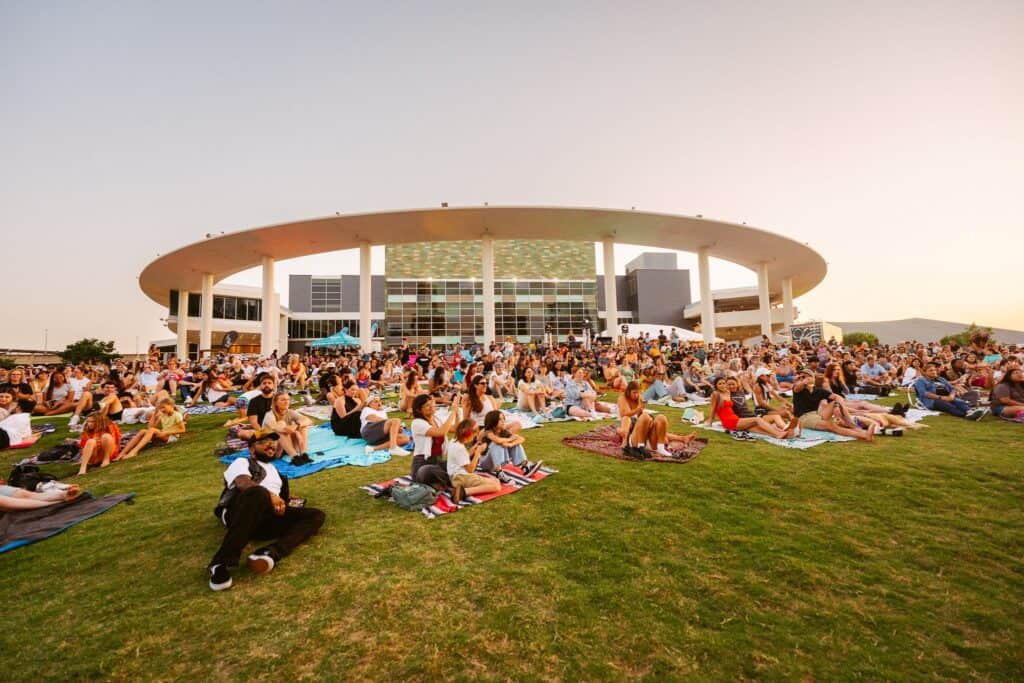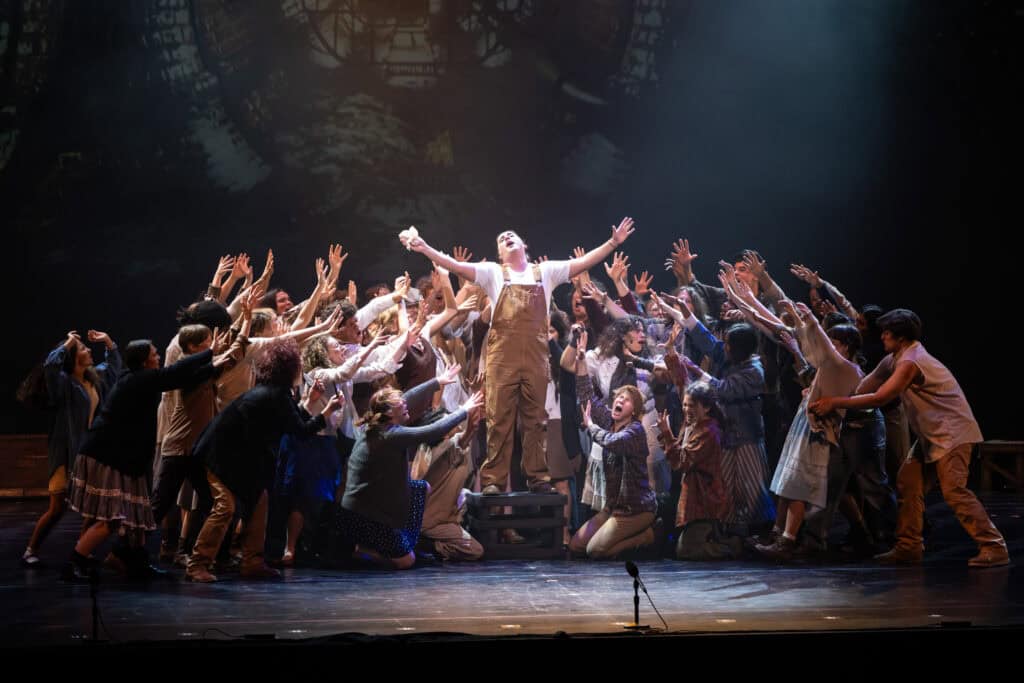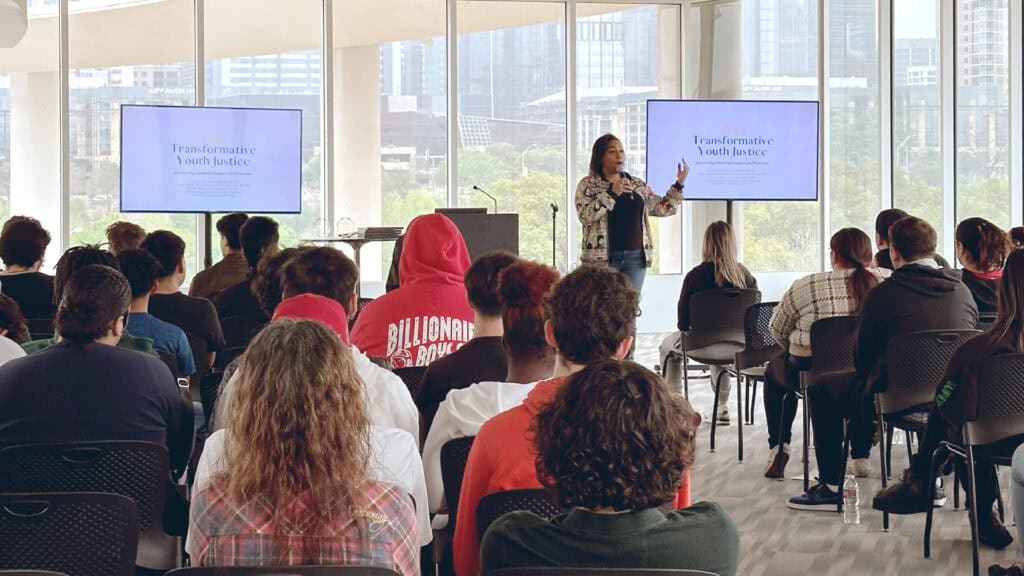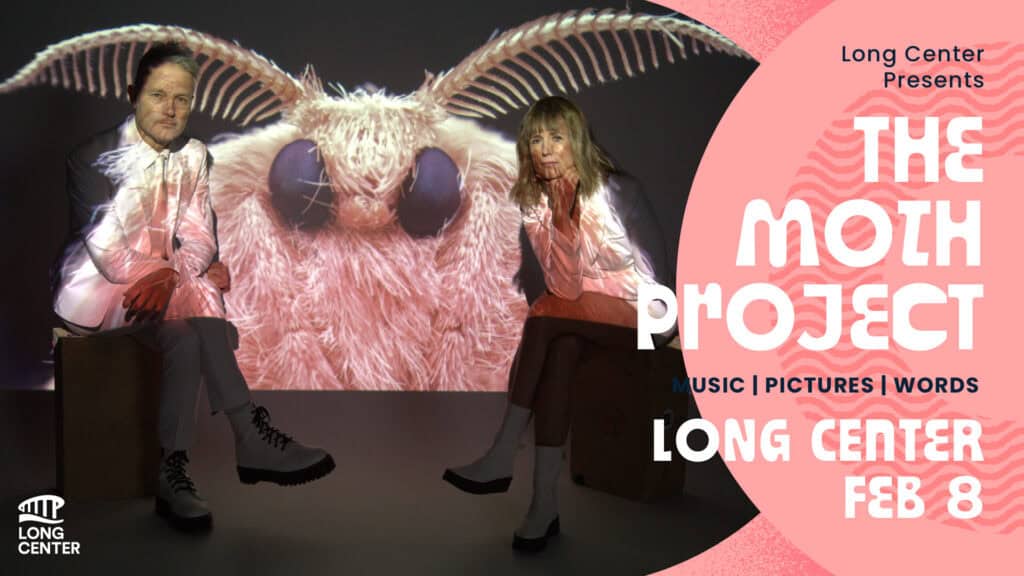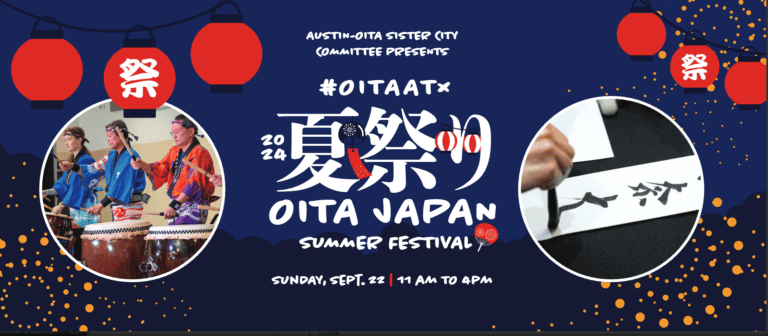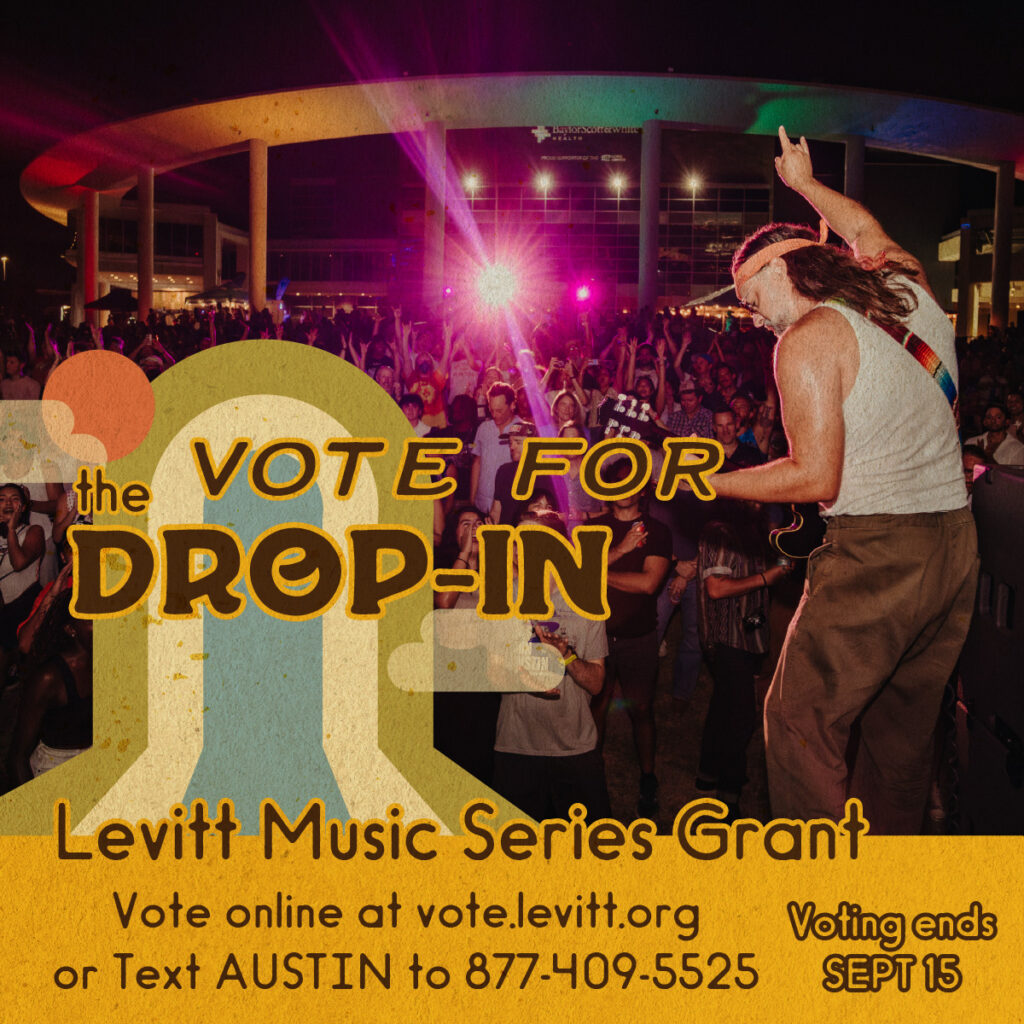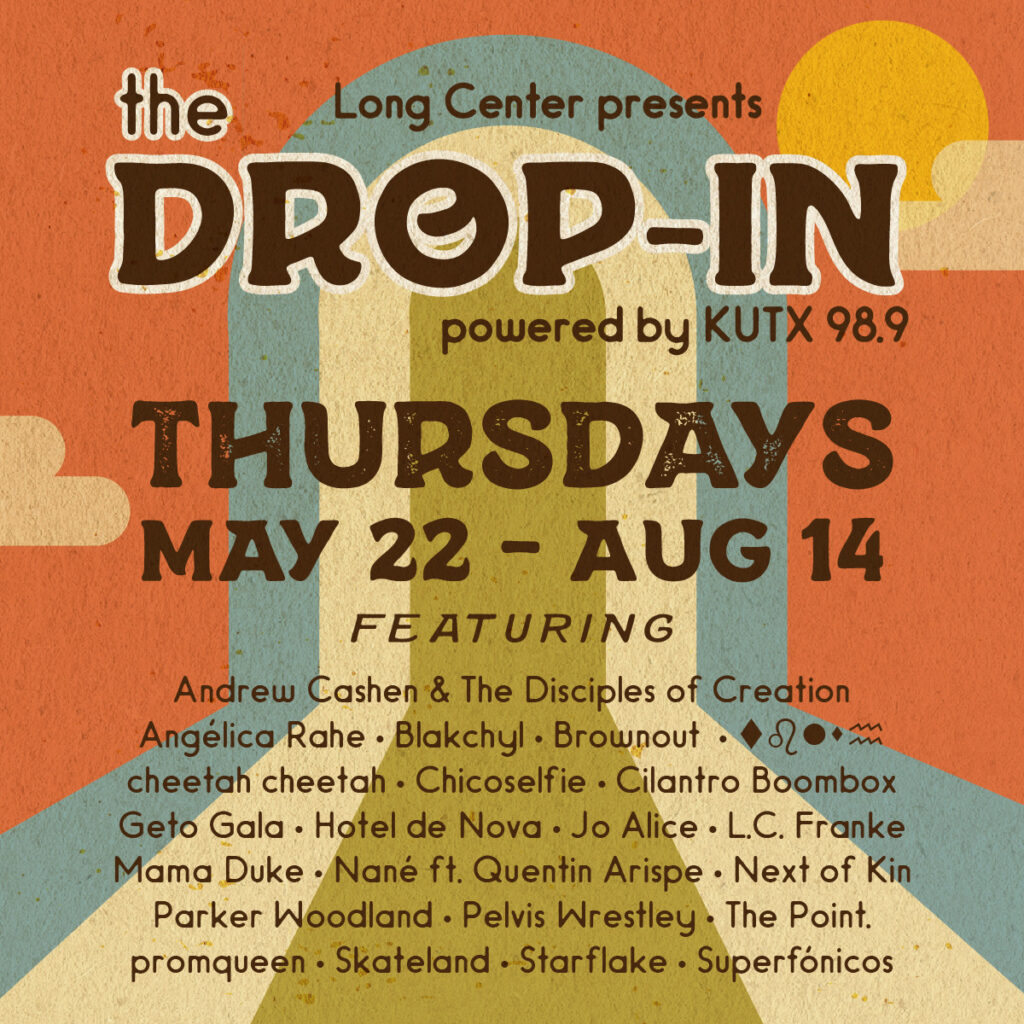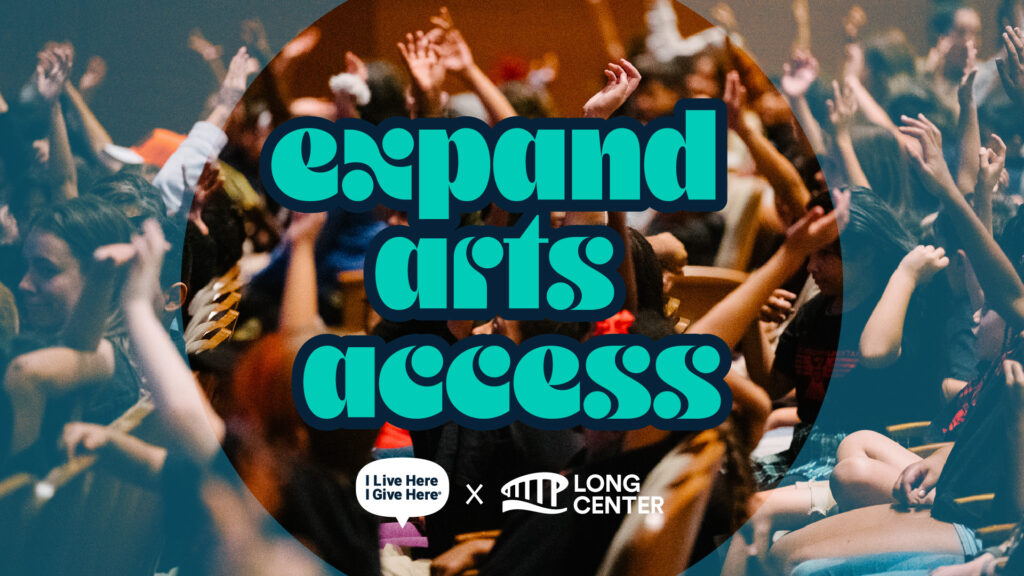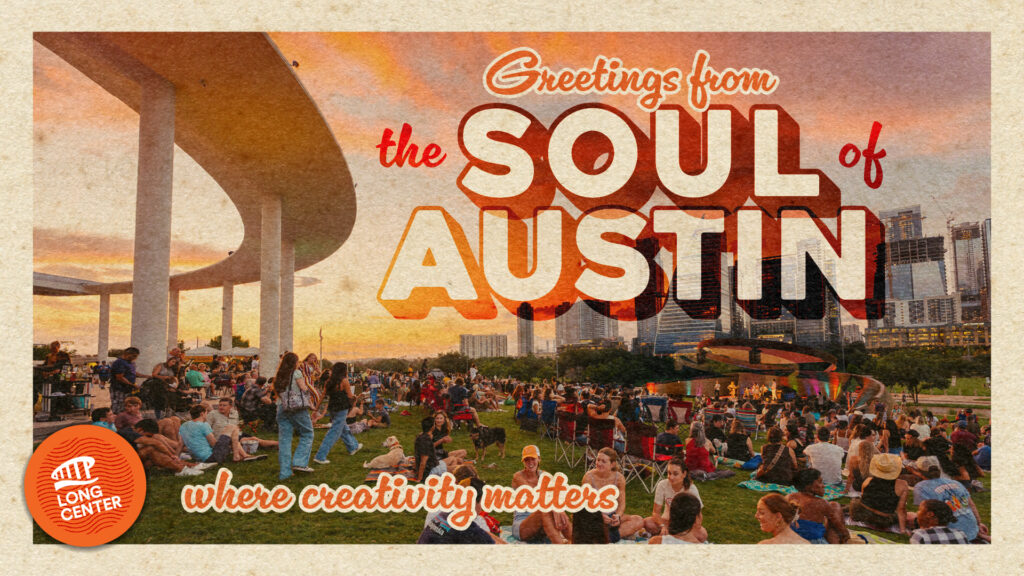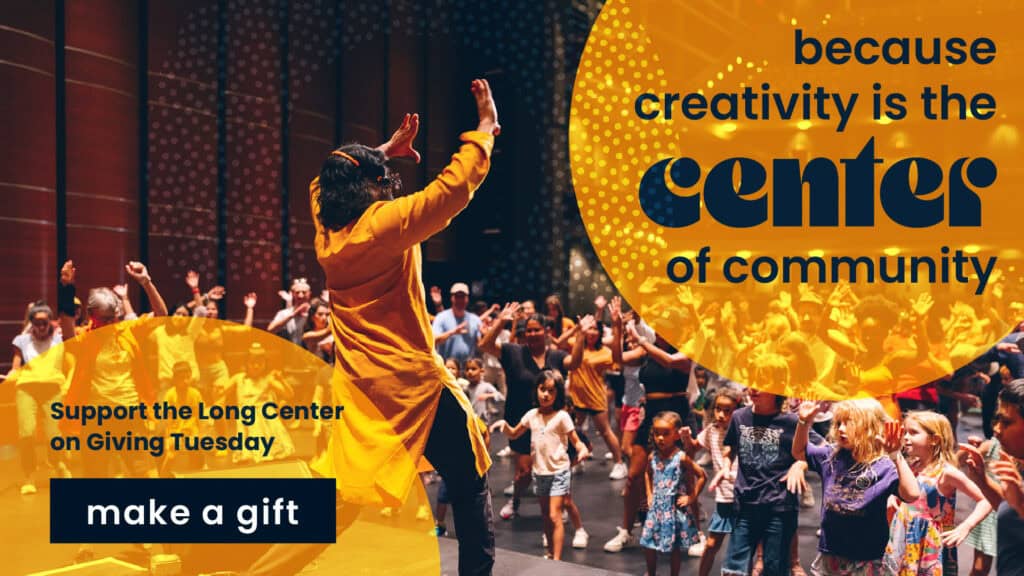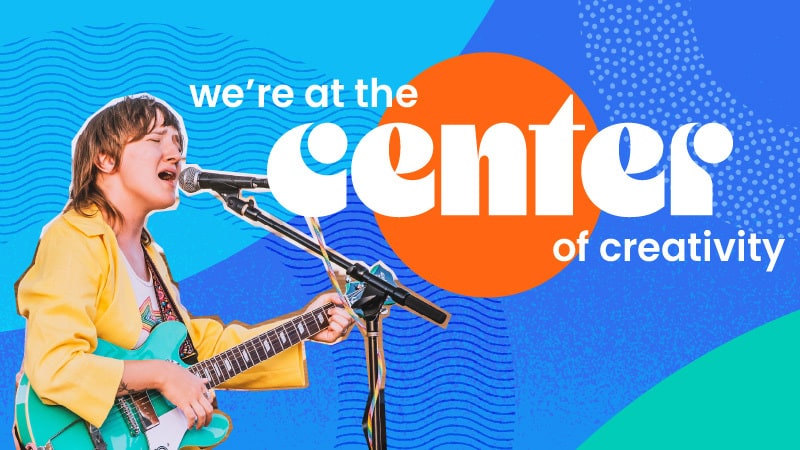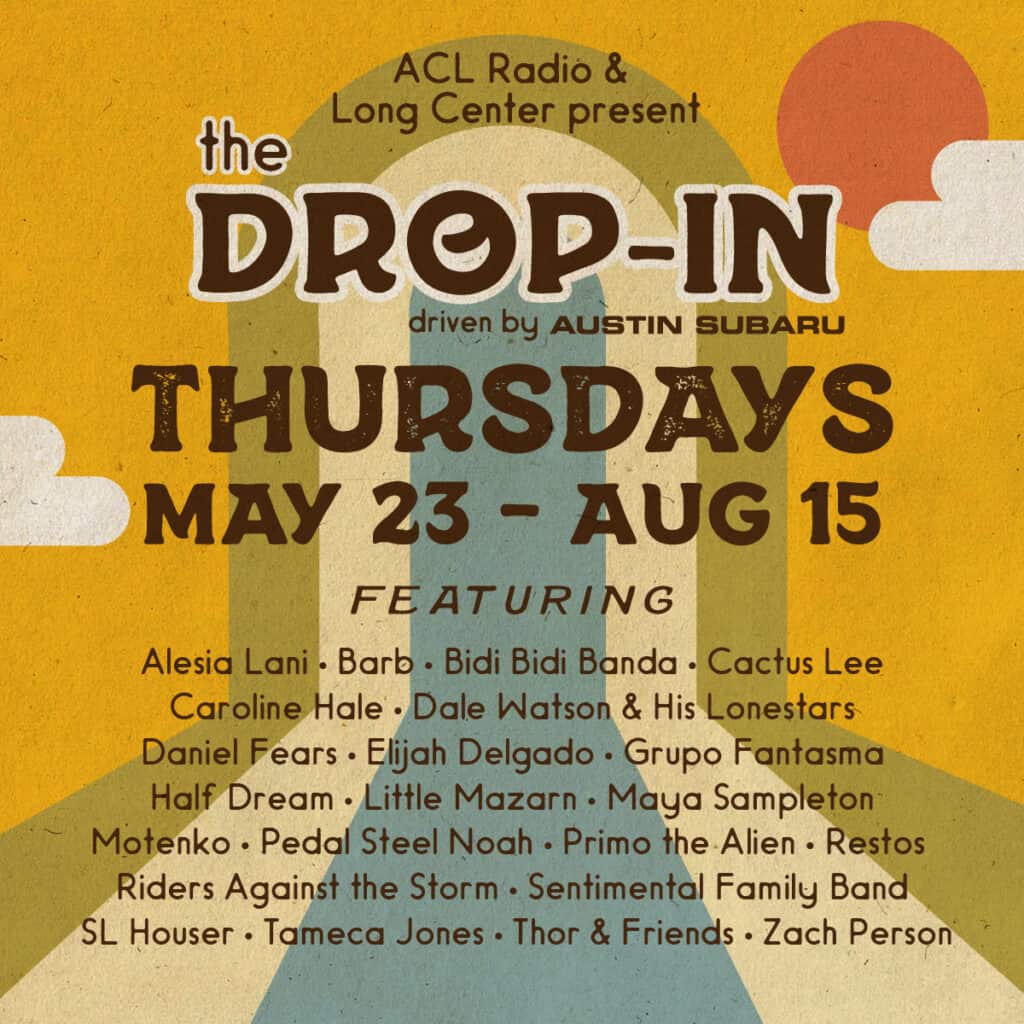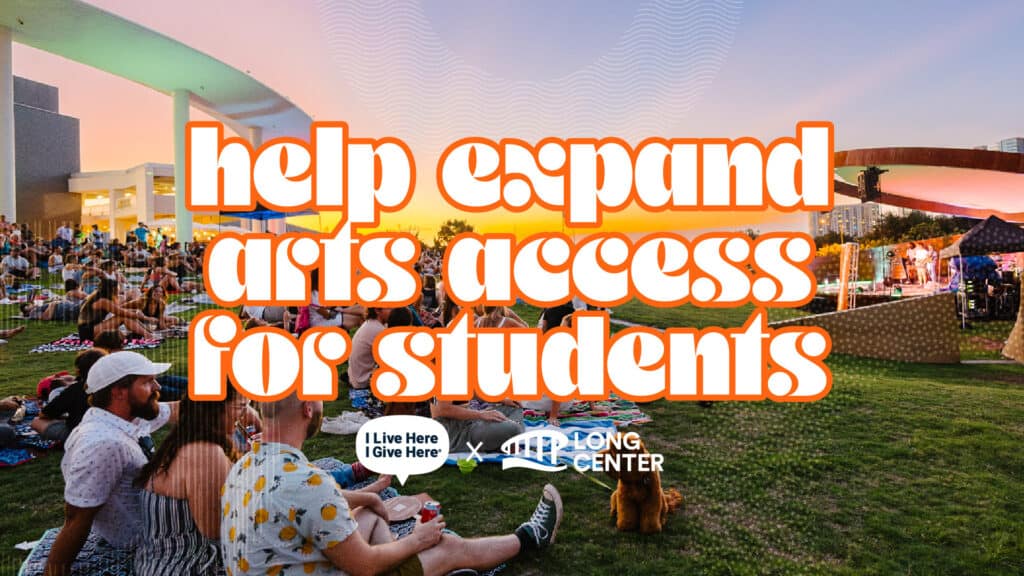
Artists performing at The Drop-In always look pretty darn cool on stage – but that’s not just because they’ve got THE vibe. The lighting team over at Natalie George Productions works hard to help make the H-E-B Stage and our artists look like the bona fide rock stars they truly are. 😎
In this Mid-Week Intermission, we chatted with Natalie George herself to hear a little more about event production and design in Austin, inspiring women to pursue technical production, and how she and her team help bring the coolest summer vibes to The Drop-In.

Long Center: Welcome to Mid-Week Intermission! We usually like to ask folks for a song to go with their interview – anything come to mind?
Natalie George: Totally random, but this morning I heard ABBA’s Take A Chance On Me when I got in the car and it totally made my day. It is such a good jam. I feel lucky that many people in my life have taken a chance on NGP, so that seems right.
LC: Can you give us a brief rundown of Natalie George Productions and everything you do there, and how NGP’s partnership with the Long Center began?
Natalie George.: Absolutely! NGP is a boutique production company that loves to produce and design events and entertainment in Austin. Our background is in Lighting design, but over the years we’ve broadened our scope to include full design and management/planning.
We’re proud to say that we have been designing lights in the Rollins since the Long Center opened! Over the years, we’ve been a part of many productions and events. We joined the Drop-In team two years ago and never looked back. AND now two former NGPers work at the Long Center. So it just feels like hanging out with family when we are there.
LC: Tell us your story! How did you come to be in event production and design?
Natalie George: I, NG, have been working in the arts in Austin for over 20 years. Originally as a Lighting Designer for theater and dance, then I became the producer of the Fusebox Festival. After working with FB to produce unwieldy events all over Austin for 10 years, I decided to start my own company!
LC: On any given day, you could find a launch party, an interactive installation, and a whole slew of live performances taking place in Austin. What’s the best thing about being in a city with so many opportunities for production and design?
Natalie George: Oh man, this is SO TRUE! The possiblities are endless. And that is exactly what I love. The room or venue, the theme or occasion, and the vibe is always changing. We love that each day is a new adventure. Most people we work with are really open to trying new things or adding some extra flare, which always makes our work more fun. We get to work in a variety of spaces, too. Rediscovering the nooks and crannies of Austin is definitely a highlight.
LC: NGP is a super cool, women-led company. How has this shaped your approach to production, and how have you learned to navigate in what’s typically a male-dominated field?
Natalie George: When I started as a lighting designer, it was a male-dominated world. And not always a welcoming space. I think this really made me want to run my own company, so I could curate the vibe exactly as I wanted it. For me, it’s all about my team. They are my family. If they’re happy, then I’m happy. And that is when we do our best work. We’ve been told by many clients that we always seem to be having too much fun. Having fun translates into having pride in what you are doing. We want to stay and get every last detail perfect.
LC: NGP does all of the lighting on the H-E-B Stage at The Drop-In (and it’s spectacular). What goes into the design process for that? Is it based on what the artist says, or do you follow your heart?
Natalie George: Why, thank you. We really follow our heart. And the beat. We are all genuine music lovers, so just letting the song speak to us always feels right.
LC: Lighting is often the unsung hero of a performance. Is there something you wished more people understood about lighting?
Natalie George: It is SO hard to explain lighting. Lol. But I think once people see it, they get it. If someone has ideas for what they want, I try and get them to explain it to me in their own langauge instead of trying to come up with lighting terms. If they can share a color, emotion, or even a song lyric, that helps me create a response that I think they’ll like.
LC: Do you have an all-time favorite project you’ve worked on?
Natalie George: There is really only one answer to this. Tiki Tatsu-ya. We designed and installed all the lighting for the bar & restaurant. It was an aboslute dream gig. Tatsu and our design partners were ALL in on the tiki theme and we got to nerd out in the best way. It is one of the only projects we have ever done that is permanent, so it is a real treat to go back and visit it.
LC: What advice would you give to young women and creatives aspiring to get into production and design?
Natalie George: Find people that you enjoy working with. Your creativity will flourish if you feel happy and supported. Be open to trying new things, but always trust your gut.
Couldn’t have said it better ourselves. See the work of Natalie and team on show at The Drop-In every Thursday through August 14!



At the Long Center, we’ve always got a new partnership or something cool we know you’ll want to check out! Find and follow us @longcenter on your social media platform of choice, and we’ll see you real soon.
Drop-In season is really heating up, and we don’t just mean the weather! To keep us cool, we checked in with Mama Duke ahead of her headlining performance on the H-E-B Stage this summer. Fresh off a recent album release — You Can Open Your Eyes Now — in this Mid-Week Intermission she tells us what keeps her writing, experimenting, and advocating here in Austin. And if you don’t know her music yet, better get listening!
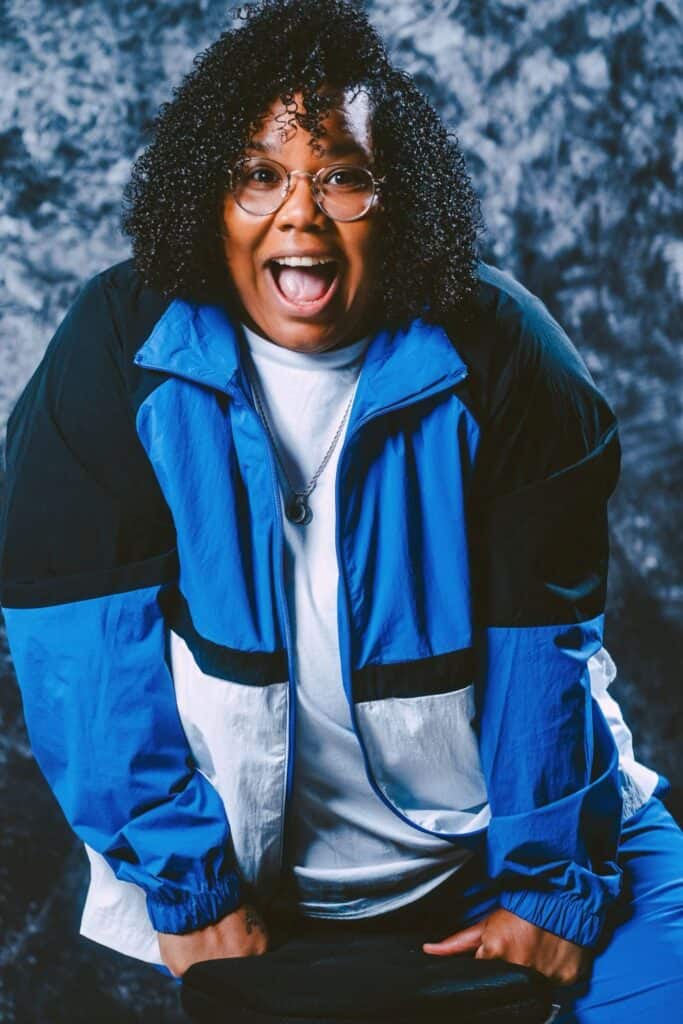
Long Center: Welcome to Mid-Week Intermission! We usually like to ask folks for a song to go with their interview – anything come to mind?
Mama Duke: Absolutely! By the time everyone is reading/seeing this, my new single “Feels So Good To Be You” will be out. It’s ironically the same song I auditioned with for America’s Got Talent. I’m so damn excited to finally share it with everyone.
LC: We are beyond excited to have you at The Drop-In this year, but before we get to the music, we have to point out that you do so much more. Can you tell us about ATX Social Club and your other projects?
Mama Duke: Sure! I always say that artists (especially musicians) are way more layered than we’re often given credit for. People hear “musician” and imagine one lane, but we wear so many hats. I used to say, “If I wasn’t an artist, I’d create a platform for artists.” A space where we’re not boxed in, where we can just fully exist.
Then it hit me — I can do that now. I don’t have to wait. That’s how ATX Social Club was born.
It started as a live-streamed hip-hop show, but it quickly evolved into something bigger. It’s a rotating hub. It’s a club, really for artists to build, share, and connect. One week we’re doing live interviews, the next it’s a jam session for the community, and then we’re sitting in a private listening session giving real-time feedback on unreleased music and demos. It’s fluid, just like us.
Lately, with my own career picking up speed, it’s naturally taken a back seat. But I”m excited to say that some things are moving behind the scenes that’ll allow me to pour more into it again soon. ATX Social Club is and will always grow as I do.
LC: We especially love your relationship with Austin FC. How did you get so involved and why is it impotant to have community spaces like Austin FC and The Drop-In?
Mama Duke: What I’ve always admired about Austin FC is how deeply they’ve been rooted in real community since day one. When they first started planting their flag in Austin, they showed out for the people who make this city what it is.
They first reached out and asked me to bang the drum and help lead the team onto the field — a moment I’ll never forget. From there, they brought me in for a commercial, then invited me to host a soccer benefit tournament, then again to host a workout camp at Q2 Stadium, and eventually even brought me back for another campaign. This time with Matthew McConaughey. And the rest is history.
What sticks with me is that they could’ve chosen any artist, big or small, at any point. But they chose me — and they keep choosing artists like me, who may not have the biggest platform yet, but have the heart, hustle, and potential to represent this city authentically.
That’s powerful. That’s why spaces like Austin FC and The Drop-In are so important. They’re not just showcasing the artists already shining, they’re helping light the fuse for the ones about to. Big names, big brands, and big opportunities shouldn’t just spotlight what’s already known, they should be bridges to what’s next. And when they do that, everybody wins.
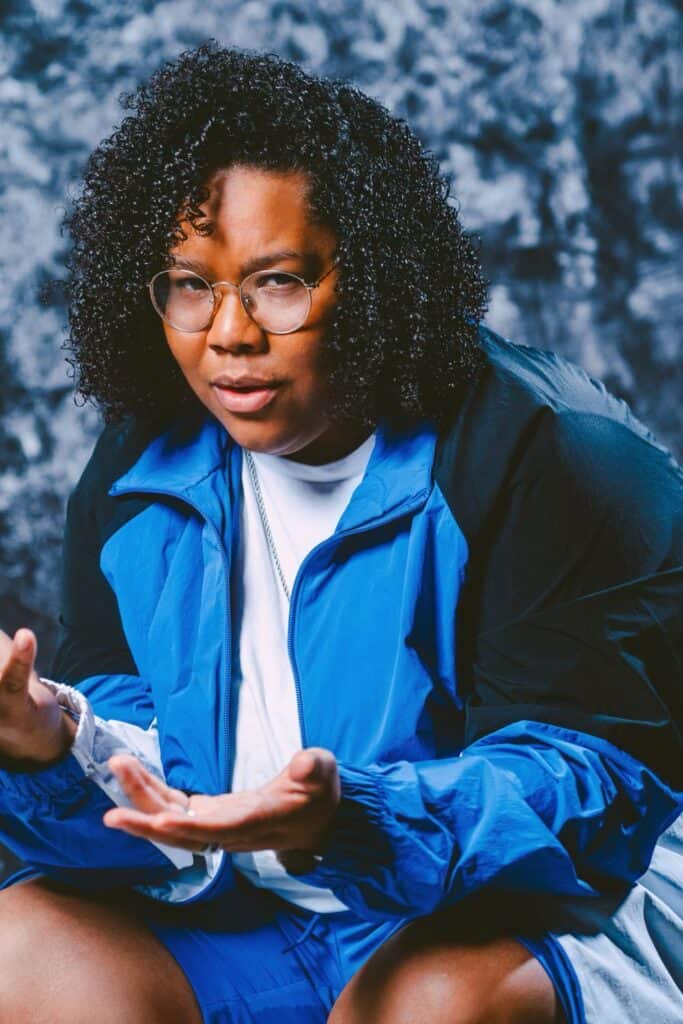

LC: We have to confess that “1987” from your newest album has been on repeat in the LC office this summer. How has it felt getting this project out? What was this album all about for you?
Mama Duke: Omg! That’s the coolest shit ever! *wait, can I cuss*? Lol! Mannnnnnn. I needed that energy this morning. It’s honestly the coolest thing in the world to pivot and drop a pop album at the top of the year and it be embraced. No questions, no concerns, just a “Hell yeah… we like this new sound!” It’s so fun performing these new songs. It’s even cooler to watch my fan base grow. There’s a whole different demographic that these songs have opened me up to and I’m loving it! This album was 100% a breakthrough into the new me. No hang-ups on what I should be doing or what genre I need to be focusing on. Just a break-up (experimental) album that worked out enough to release! lol
LC: You are everywhere right now. Austin Woman Magazine’s “2025 Change Makers,” The Contemporary, awards & collabs galore, and all over The Austin Chronicle.
What did it feel like to be called a “local rap icon,” as they said?
Mama Duke: I have truly waited my whole life for these opportunities and exposure. Imagine how delusional you have to be to see this in your future. But I saw it! There’s a feeling everyone has that they should be doing something and I’ve been fortunate enough to have been tuned into my inner voice for as long as I can remember. Of course I have doubts. I still have a normal job that humbles me. Lol! But I’m lucky enough to have changed my perspective on it all. The goal is obviously to do this full time but there’s lessons in all this. How cool is it to say that I’m headlining one of the nights of The Drop-In? What a wild wild wild wild wild wild wild ride. I want people to know that you can really create your own reality by yourself.
LC: What’s your take on the Austin hip-hop scene, and how do you think it’s changed since you got started?
Mama Duke: You know, if I’m being transparent, all of my friends are experimenting these days. So the “rap scene” that I started out in is slowly looking like something else. Maybe I’m not tapped in enough? That could be a possibility but my experience is that the small spotlight Austin put/puts on the rap scene has caused a lot of artists to explore and pivot. We are by no means leaving the rap scene but I think some of us are such big hustlers that we haven’t slowed down enought to even think this question out fully. We’re too busy out here making it happen!
LC: Do you think there’s a “secret sauce” for Ausitn where music is involved? What keeps you writing and creating here?
Mama Duke: Yes! I think people are so bothered with a ton of people moving here but I choose to look at it through a different lens. How cool is it that people want to come to the place where we’ve already got planted roots? We know the streets, we have the connections, we have the contacts, etc. I think Ausitn feels so alive lately. The security sauce is finding your community. Finding the like-minded folks that move how you move — want what you want, and can move the needle. The secret sauce is making your own magic!
LC: And because we can’t wait — what can folks look forward to at your Drop-In set? Any teasers you can leave with us?
Mama Duke: I’m performing with my first full band for this set! Sheeeeesh. I had to bring out all the tricks for this one! …and obviously the biggest one (I spoiled in the first questions) is that I’m performing my new single for the very first time. The same song I auditioned with on America’s Got Talent, “Feels So Good To Be You” — what is even life right now!
Thanks, Mama Duke!
Keep your eyes on @longcenter on social media so you don’t miss Mama Duke with Skateland at The Drop-In.
🌟 Don’t forget, it’s FREE
✍️ RSVPs appreciated
🤙 Drop-ins always welcome
At the Long Center, we’ve always got a new partnership or something cool we know you’ll want to check out! Find and follow us @longcenter on your social media platform of choice, and we’ll see you real soon.
Okay The Drop-In Season 5 just started and we are riding high on last week’s kick-off performance from Brownout! Not only are we excited for another Drop-In summer, but we’re doubly pumped to be partnering up with KUTX 98.9, Austin’s beloved NPR music station. To get their take on Austin music and everything we’re looking forward to this summer, we caught up with Matt Reilly, Program Director for KUT & KUTX, to learn more about how he plans to Drop-In this summer.
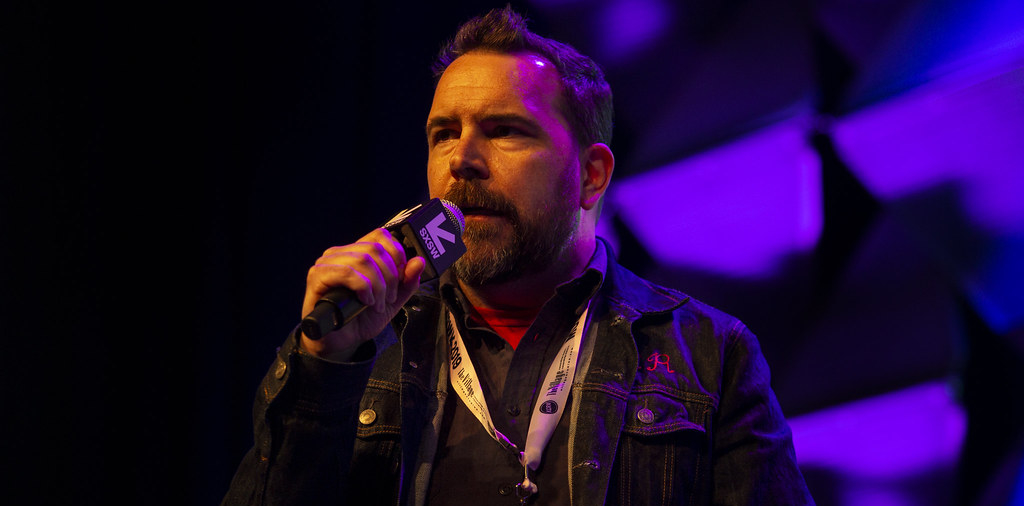
Long Center: Welcome to Mid-Week Intermission! We usually like to ask folks for a song to go with their interview – anything come to mind? Maybe a song from an artist on The Drop-In lineup?
Matt Reilly: How about La Semilla from Superfónicos? Like a seed, this one grows on you.
LC: Speaking of — this is the first year that KUTX is partnering with the Long Center on The Drop-In! And, of course, we’re stoked. Can you talk a little about how that came to be, and why it makes sense?
Matt Reilly: You fine folks at the Long Center have always booked incredibly well for The Drop-In, and we’ve just been biding our time until you asked us to partner with you. And you did!
LC: The Drop-In is just one part of KUTX’s Wet Hot Austin Summer programming. Care to share a little more on that, and what folks can expect?
Matt Reilly: The best soundtrack to your summer in Austin, for starters. We’ll also have ticket giveaways and other events to join us in person.
LC: What’s your favorite part of the summer season at KUTX?
Matt Reilly: We really lean into all the fun that the city has to offer in the summer. If you play it right, summer in Austin can be like to going to summer camp. And we think about that as we’re putting the music together.
LC: What are you most excited about for this year’s Drop-In? Any artists you’re epecially looking forward to?
Matt Reilly: That’s like asking me to pick my favorite child. All of them, of course! I will say though, there is a healthy contingent of former KUTX Artists of the Month and we have lots more to explore on these artists at our webiste — kutx.org. See what I did there?
LC: Lightning Round ⚡ Are you a blanket or lawn chair kinda guy? Hat or sunglasses? Get there when doors open or right when the show starts? How do you Drop-In?
Matt Reilly: Lawn chair, sunglasses, right when the show starts.
LC: Do you remember the first local artist you saw in Austin? And any advice for folks who haven’t come out to The Drop-In before?
Matt Reilly: I remember seeing Alejandro Escovedo at Shady Grove, back when that series was happening many moons ago.
As for the folks that are Drop-In curious, I’d say that these are some of the best Austin artists going right now and the price really can’t be beat. Oh, and there’s a breeze so it gets quite comfortable as the sun goes down.
Thanks, Matt!
Come check out The Drop-In this summer on the H-E-B Stage, and don’t forget to stop by the KUTX tent and say hi!
And did we mention it’s FREE?
At the Long Center, we’ve always got a new partnership or something cool we know you’ll want to check out! Find and follow us @longcenter on your social media platform of choice, and we’ll see you real soon.
The Drop-In 2025 lineup is out and it’s no surprise that we have some opinions in the house! At the LC, we’re a collection of superfans, ride-or-dies, and intense consumers of Austin’s creative arts scene, so when we asked for Drop-In ‘hot picks,’ the team certainly delivered. Check out what they had to say about this stellar lineup (spoiler: we like them all) and start putting together your own can’t-miss, won’t-miss list.
Special Mention: There was someone who just couldn’t choose, so he made a radio show about it instead. If you didn’t catch Saturday’s My KUTX on KUTX 98.9 with our own Bobby Garza, Chief Program Officer, then you really missed out! Just kidding — if a curated playlist with a personal touch is what you’re looking for, Bobby really delivered. Listen here and mark your favorites (or, you know, just plan to see them all ✨)
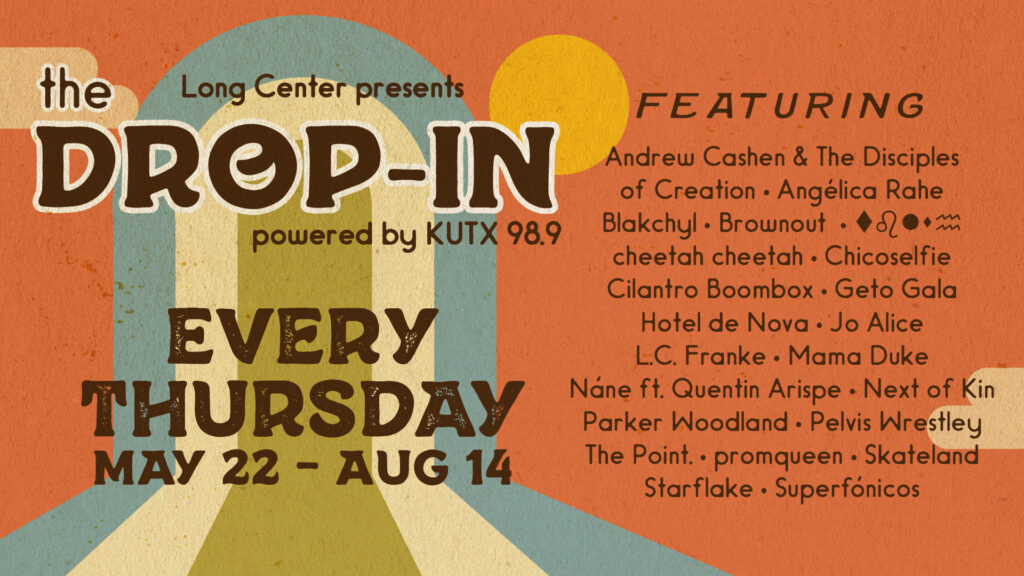
WE ASKED:
The whole lineup is solid, but who are you most excited to Drop-In this summer?
Matt from Programming
// Chicoselfie
The band combines classic elements of Latin rhythms, pop, and rock with flares and nods to the faves we all know and love like Caifanes, Mana & Café Tacvba.
A wonderful Austin take and some great songwriting makes this my pick not to miss.
Leslie from Box Office
// Brownout
// Superfónicos
// Andrew Cashen
I can’t wait to see Brownout and Superfónicos! Anything that Adrian Quesada does is a fun time.
And the enigmatic Andrew Cashen is always an exciting experience for all!
Such a great lineup to attend on Thursdays, all summer long.
Katie from Marketing
// Next of Kin
I loved Flora and Fawna who played The Drop-In a few years ago, so when I saw Lili Hickman’s new band Next of Kin was playing this year, I knew that was going to be one I couldn’t miss. Love their energy and those harmonies are insane! It’s going to be such a vibe for a summer Austin night on the lawn!
Dallas from Programming
// The Point.
I think I have an algorithm to thank for putting these guys on my radar.
A driving beat selling a groove that you can’t help but nod your head or shake your booty to.
The band itself, comprised of the perfect combination of youthful zeal and a steady experienced hand keeping tempo, all with a great ear in the studio with Beto Martinez producing, demands attention and proved the point that Austin’s music scene is alive and kicking.
Dana from Programming
// L.C. Franke
I’m looking forward to L.C. Franke classing up the lawn with some tortured torch songs!
Kelsey from HR
// Pelvis Wrestley
I watched Pelvis Wrestley play years ago at a dive bar and the place just came alive! So looking forward to seeing them live again on our stage!
Maria from Community Programs
// Starflake
I’m most excited to see Starflake! Starflake is a 2024 Austin Live Music Fund awardee, and their music makes me want to dance!!
Jordyn from Marketing
// Nané ft. Quentin Arispe
The outdoor stage is the perfect setting for Nané and Quentin Arispe. They both have such a great vibe and energy, and their music sounds the way a hot summer night on the lawn feels.
Riley from Programming
// The Point.
// Next of Kin
I mixed songs for both bands at this year’s Sonic Guild Ball and I was immediately blown away by their sound! Next of Kin’s vocal harmonies and The Point.’s vibey, groovy rhythms are something you should experience.
Jordan from Box Office
// All of them
I’m not familiar with any of the bands because I’m new to town. I’m so excited to experience them all as both a staff member and a new Austinite. From what I’ve heard, we are in for a treat, and I can’t wait to find my new favorite local musician!
And there’s so much more where this came from! You can’t go wrong with any Drop-In, and that’s our favorite thing about it. Make sure you’re signed up to get RSVP alerts on Mondays (remember, it’s free) and we’ll see you there! Oh, also keep an eye out on @longcenter for Friday artist reveals.
At the Long Center, we’ve always got a new partnership or something cool we know you’ll want to check out! Find and follow us @longcenter on your social media platform of choice, and we’ll see you real soon.
Today is a special day, as it’s the last time all of us at the Long Center will get to host the Heller Awards, otherwise known as Austin’s Tonys for high school musical theatre. But before the program moves to its new home at Texas Performing Arts, we took a stroll down memory lane and even got some of our staff to reflect on the last 12 years of this incredible program.
So before the show begins tonight — and yes, you can still snag a ticket — peruse through the highlights, hear from our staff, and review the nominees for tonight’s Twelfth Annual Heller Awards for Young Artists. After all — we’re in a show!
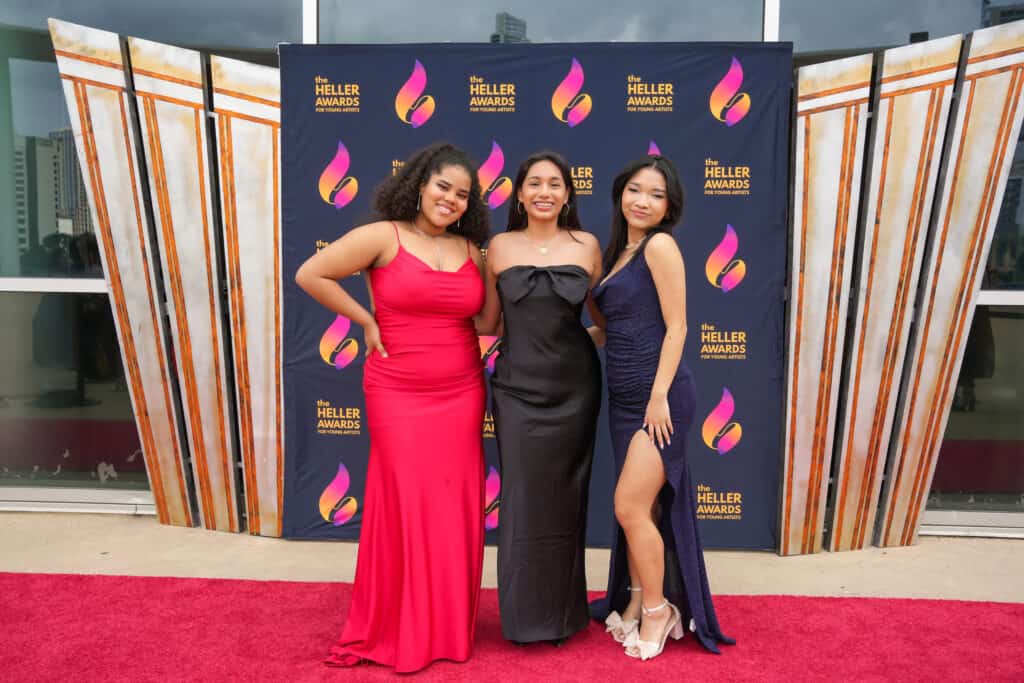
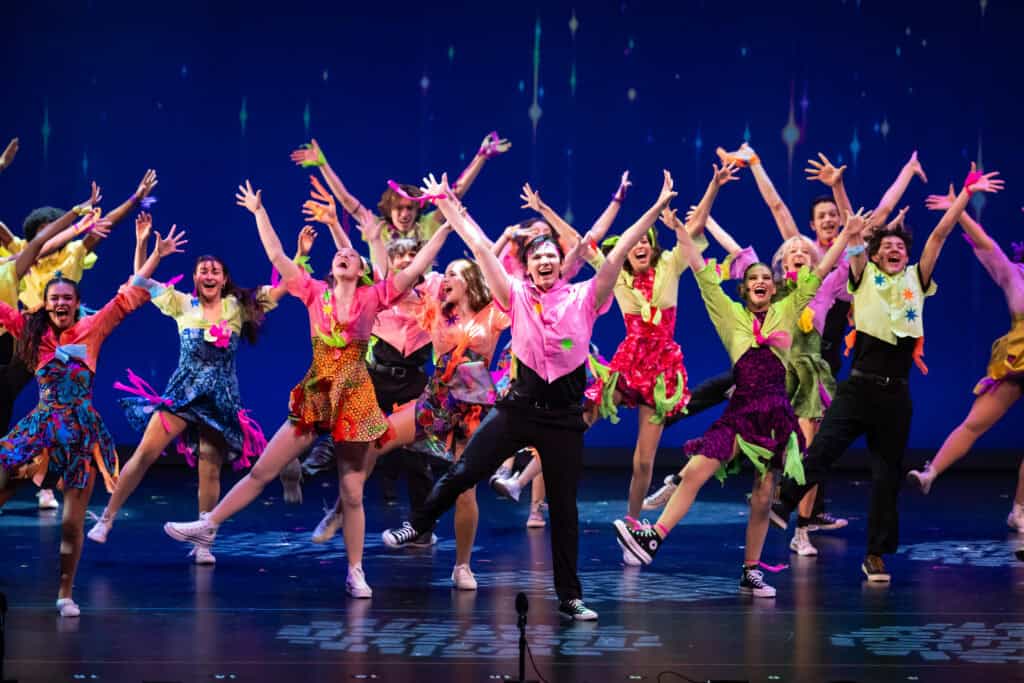

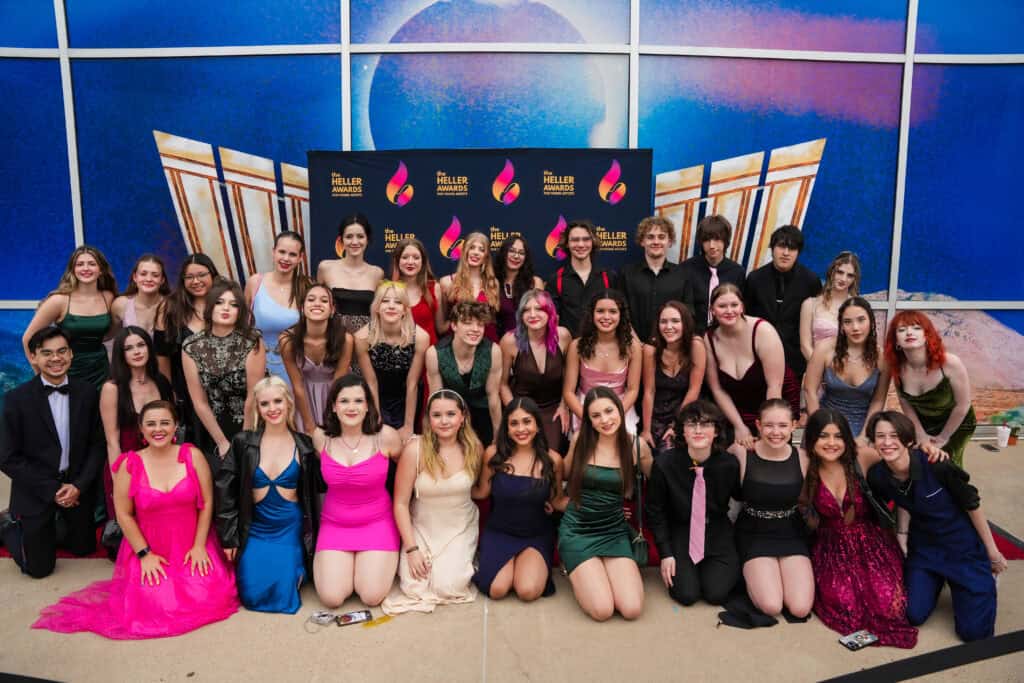
IT’S HELLER AWARDS SEASON
Need a refresher on what this is all about? Check out our Heller Awards 101. It talks you through the year-long program from start to Ceremony. It’s free to participate, reaches across 7 counties, and the Select Ensemble is pulling out all the stops this year.
And did we mention that the program began in 2014 with 19 participating schools, and twelve years later we’re celebrating with 37? Originally known as the Greater Austin High School Musical Theatre Awards, the show always features musical numbers by 8 Best Production Nominees, leading & supporting medleys, and much razzle dazzle. There’s been a big team from different organizations behind the scenes putting it together over the years, but the real drive comes from Producing Director Ginger Morris, whose direction & choreography is on show in every Ceremony and workshop. We can’t wait to see how this continues to grow at Texas Performing Arts.
“My favorite GAHSMTA / HAYA memory is how many times I’ve been brought to tears.”
“This show is a big and complicated project on an improbable technical timeline. I’ve had the pleasure to work every one of Ginger’s High School awards shows. The first six years as the Sound Designer/Operator. The energy in the room, the intensity from the performances, the perfection when it all comes together brings tears to my eyes.
Ginger, you have my heartfelt well wishes to keep your meaningful work going in our theatrical community. You make a difference for many creative youth. Thank YOU!”
— Ken from Production
GOOD VIBES ONLY
What’s been the most fun to watch, however, is a super supportive creative community form before our very eyes. Many of the students in our 37 particpating schools go to see each other’s shows, and then encourage others to go see even more shows. And then before you know it, there aren’t just thousands of Instagram likes, but also authentic connections being formed.
You can see which schools are participating this year and also the Select Ensemble on show in our 2025 Nominee Livestream (hope you like Wicked!). And if you’re curious about what it’s like stepping onto the Heller Awards scene for the first time, we’ve got some advice from last year’s leading ladies.
“As a former theatre kid, I love the talent, energy, and excitement that all the students bring to the Heller Awards. I have been on staff at the Long Center for over 4 years, and what always impresses me is the supportive environement that is created for the students.”
“When all the best performer nominees are gathered together on stage as the nominees are read and the winners are announced, the scream of excitement for the winner is genuine and heartfelt (and ear splitting!). The kids truly support each other.
For me, part of the excitement is knowing that all the kids participating in the program clearly have such bright futures regardless of whether or not they choose the performing arts for their life-long careers.”
— Anne from Box Office
HOSTS WITH THE MOST
With the reach of this program spanning over a decade, you might be unsurprised to hear that there are quite a few alumni out there. Plenty are working in the arts, whether on stage or as arts administrators. Plenty more have chosen paths in creative fields, and of course, some who continue to support the arts from other sectors.
We’ve had several Broadway shout outs over the years from stars AND alumni on major tours — a particularly memorable one comes to mind featuring the cast of Hamilton trying their best to pronounce “GAHSMTA” (what the Hellers were formally known as).
Better still, we have two alums hosting the show for the fourth time this year — Donelvan Thigpen & Jessica O’Brien — each with their own impressive stage credentials. And we even have alums like Dave Hawks who continue to come back to photograph the show, red carpet, or Trophy Room to support the program because it means that much. Dave was even in the very first Awards Ceremony, way back in 2014.
“I’m proud (and shocked) to say this is the 6th Heller Awards I’ve been lucky enough to be a part of.”
“The passion, dedication, and talent these young people exude is so incredibly inspiring and every year I’m brought to tears, despite my best efforts. I’m filled with hope knowing the torch is being passed and knowing how important events like this are to our young creators.
I’m thankful to have been a part in as many ways as I have. Cheers and best wishes, Heller Awards!”
— Hannah from Marketing
“Nothing compares to the energy of 500 high school students.”
They are excited, nervous, and genuinely thrilled to take part in the Heller Awards. It is best described as ‘electric.’
In an increasingly screen-focused society, each year I am reinvigorated in my belief that live performing arts will always be relevant; and it’s because of these kids.”
— Dallas from Programming
A SHOW FOR SHOWSTOPPERS
While the show still hits our favorite beats after twelve years, including the spine-tingling opening number that was written for the program by Allen Robertson, there’s always a surprise. Make that surprises, plural.
We’ve had a City Council member burst into song as King George (he did great!), and the show has even opened with our host conducting the first number. But what takes the cake is Rouse High School’s very own Langston Lee winning the national Jimmy Award for Best Performance by an Actor the very first year the Heller Awards were able to participate. Incredible.
“This sounds silly, but after 9 years of working on the Heller Awards, that opening number still gets me every time.”
“Something about the timing, the music, the always-new staging and the importance of the moment… you just can’t help but feel the magic. We’re definitely in a show.”
— Catriona from Marketing
“When Austin’s own 2023 Heller Award winner Langston Lee went on to win the Jimmy Award in New York City, the entire city of Austin as cheering!”
“I want to wish all the nominees the best of luck at the Awards, but please know… you are ALL winners!”
— Anne from Box Office
This is just the tip of the iceberg for this program, and we hope you’ll follow along as it moves to Texas Performing Arts next year.
Cheers to 12 years — it has been a wild, fulfilling, whirlwind of a ride. And as we all know, there’s no business like show business.
See you at the Hellers!
Photos by Henry Huey and Dave Hawks.
At the Long Center, we’ve always got a new partnership or something cool we know you’ll want to check out! Find and follow us @longcenter on your social media platform of choice, and we’ll see you real soon.
Sometimes trying something new has a big impact, and that’s exactly what’s happening at the Long Center! Once a month Transformative Youth Justice takes over one of our spaces to create a safe, holistic environment for ages 17-20 as they participate in this innovative court-led diversion program, led by Judge Denise Hernández. Read on in this Mid-Week Intermission to learn a little more about the creative ways Judge Hernández and the TYJ team are making big impact!
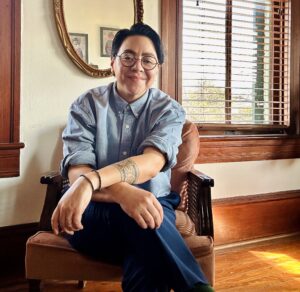
Learn more about Transformative Youth Justice with Judge Denise Hernández
Long Center: Welcome to Mid-Week Intermission! We usually like to ask folks for a song to go with their interview – anything come to mind? Is there one you like to play before starting a session of Transformative Youth Justice?
Judge Hernández: When I think of a song to go with this interview, I automatically think about Morning Asana by Londrelle. It represents the energy and balance I hope participants receive in the program.
LC: Most people won’t know what Transformative Youth Justice is. Can you tell us more about the program?
Judge Hernández: The Transformative Youth Justice (TYJ) Program is a court-led diversion program for individuals between the ages of 17-20. The program utilizes a holistic community-centered approach to provide participants with developmentally-appropriate support, intervention, and case management. This age group is experiencing a pivot moment in their brain development, and the program takes this into consideration to help decrease recidivism for this age-group long-term. By focusing on intentional programming held in the community instead of the courtroom, the program helps eliminate systemic barriers to community support and increases long-term success for the participant.
The goal and vision of TYJ is to reduce recidivism and increase public safety by building a continuum of care centered in holistic community support for all program participants.
LC: How did TYJ start and how did you get involved?
Judge Hernández: TYJ started in 2023 as a collaborative effort between myself and Travis County Attorney Delia Garza. There is significant research that shows that a non-traditional docket approach, community support, and one-on-one case management will help decrease recidivism for individuals between the ages of 17-20. I took the time to meet with national research organizations to address justice system involvement among emerging adults of this age and began implementing the research into practice by creating the TYJ structure.
Motivated by my own lived experience of being system impacted, I worked with county Attorney Garza to create a program that was holistic, research-driven, and trauma-informed to help decrease system involvement for the youngest members of the adult justice system. Within a month of being on the Bench, I moved the program into community space and began building a resource network to host monthly resource fairs for the participants. The program continues to maintain a recidivism rate of less than 10%.
LC: TYJ has been taking place at the Long Center for over a year now. Why did you decide to find an “unconventional” space to host it?
Judge Hernández: I intentionally reached out to the Long Center to discuss hosting our TYJ monthly meetings because the Long Center represents community, creativity, and soul. There are so many soulful events that take place at the Long Center, but many of our participants have never even stepped into the venue. By hosting our meetings at the Long Center, we remind our participants that they belong. The space is intentionally designed to create a welcoming environment of creativity and soul, and you can feel that in every monthly TYJ meeting. By hosting our meetings at the Long Center, we intentionally create space that calms the nervous system, creates safety, and makes it easier for the participants to connect with the resources on-site.
LC: How does being in a creative setting help set the tone for the program?
Judge Hernández: We are intentionally creating an innovative approach to a diversion program. Think TED Talks for youth impacted by the justice system. Being in a creative setting allows us to create a tone of inspiration and hope for the program. Every month, we host speakers that present on topics like “making good choices,” “trauma responses,” “how to start a business,” all with the idea to inspire. We want participants to walk away from each meeting with the belief and knowing that they can change the direction of their lives. Being in a creative space helps us instill that belief into every single meeting.
LC: How have you seen the program and the impact change in the last year since switching locations?
Judge Hernández: We are bringing participants to the heart of the city by hosting TYJ meetings at the Long Center. You can see the impact of the location in the demeanor of each participant. They feel safe, they feel inspired. Since moving locations, we’ve had many participants bring their children and/or parents with them to the monthly meetings. It’s become a space of resource connection and support. Typically, in a traditional court program setting, participants would attend meetings in the courtroom. The courtroom can be a very triggering space for people, which makes people apprehensive to ask for help or support. By moving the meetings into the Long Center, we help remind participants that we are all interconnected and it’s okay to ask for help and support. At the Long Center, participants are asking for help, leaning into the resources, and working to make better decisions for themselves.
LC: What do you hope the program achieves in the future?
Judge Hernández: I hope the program becomes a national model for reducing recidivism for the youngest population impacted by the adult justice system. I dream that the program turns into a multi-agency program that brings together many sectors of our community to help address a major community issue. Together, we can create impactful change, and I’m grateful for the Long Center partnership to help bring this program to life!
At the Long Center, we’ve always got a new partnership or something cool we know you’ll want to check out! Find and follow us @longcenter on your social media platform of choice, and we’ll see you real soon.
You know we love a good art + science combo. But throw moths into the mix?? We’re sold. We caught up with the creators of The Moth Project, an interdisciplinary project headed to the Long Center on February 8 centered all around — you guessed it — MOTHS. Read on to discover the ins and outs of this one-of-a-kind show.
Meet The Moth Project's Peter Kiesewalter & Whitney La Grange
Long Center: Welcome to Mid-Week Intermission! We usually like to ask folks for a song to go with their interview – anything come to mind?
The Moth Project: How about “Migration” from the album?
LC: So what exactly is The Moth Project? What can the audience expect?
The Moth Project: The Moth Project is a 75-minute multidisciplinary live show at the intersection of art and science. It features two musicians performing an eclectic set list in front of a large video screen while a range of macro photographs, slow motion video capture, and motion graphics are projected onto them.
The audience can expect moths, for sure — images, video, science, mythology — but also a between-song narrative arc about one family’s migration from Europe to North America and how we, as humans, connect with the natural world.
LC: You’re both multi-faceted musicians, as demonstrated in the show. Can you share a little bit about your backgrounds?
The Moth Project: Peter is from Canada, where he got a degree in classical clarinet performance by putting himself through school playing keyboards in rock, country, and jazz bands. He moved to NYC in 1997 and has worked as a composer and music director there since, including stints as resident composer at ABC Television and leading his own group, the East Village Opera Company, to a record deal with Decca/Universal, recording three albums (including the Grammy-nominated “Olde School”), and touring all over the world.
Whitney was born in Austin and grew up in McAllen, TX. She studied classical violin performance at the Julliard School in NYC, Yale, and earned her Masters from the University of Illinois. She plays in the pit for countless Broadway shows and performs with a wide range of artists, such as Billy Joel, Jon Batiste, Natalie Merchant, Andrea Bocelli, and Josh Groban to name a few.
LC: Why moths? What was the inspiration for the show?
The Moth Project: During the pandemic summer of 2020, Peter was in quarantine with Whitney, his three children, his brother Tobi (an Interpretive Naturalist for Parks Ontario) and his three children. Over evening campfires, while watching moths drawn to the flame, he began to imagine a show in which the mythology of “moth to the flame” is examined. What’s that about? Why do they go to the light, the flame?
Tobi began taking pictures of moths that summer, a hobby called “moth-ing.” He documented over 600 different species, a number and variety that was stunning to witness. His images, along with Peter’s own deep dive into moths in literature and art, were the catalyst for the show’s basic premise — a show with integrated visuals, noting the similar themes faced by all living creatures like life, death, transformation, migration…
A big influence was the book “Braiding Sweetgrass,” a New York Times best seller written by the Indigenous author MacArthur Fellow and professor Robin Wall Kimmerer, who asks, “in a world that gives us maple syrup, spotted salamanders, sandhill cranes, Douglas firs… isn’t it time we paid attention?”
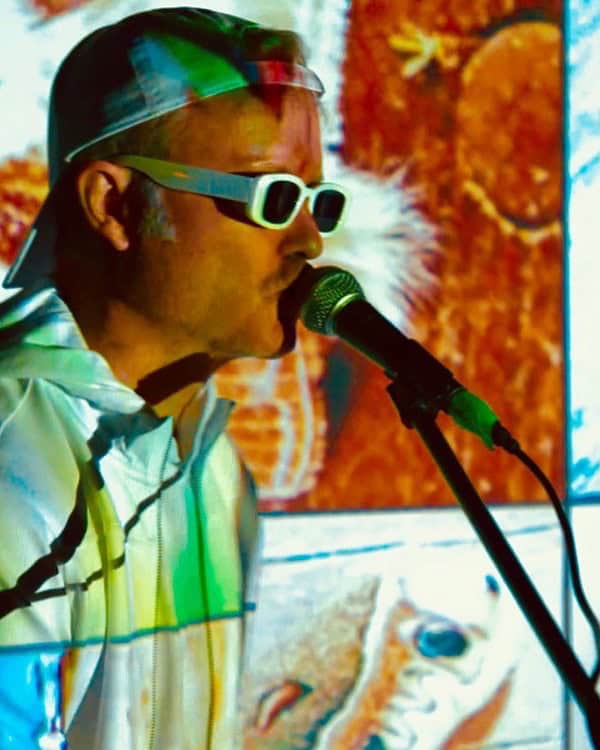

LC: As you said, this project is a combination of art and science. What is it like to turn what many think of as opposites into one shared performance?
The Moth Project: Art and science have been intertwined throughout history, particularly during the Renaissance. Artists like da Vinci used scientific inquiry to inform his art. More recently it seems like science has become politicized. We like to think of the two disciplines as two sides of the same coin — that the way we see and experience the natural world benefits from a “hearts AND minds” approach.
For example, when looking at biodiversity through both lenses, science tells us that it is important because it supports nutrient cycling, pest control, water purification, and climate regulation, while art would look at the same ecosystem and say that biodiversity is beautiful. Both are important. The case for the importance of cultural diversity is equally simple — organisms thrive in diverse ecosystems, be they natural or cultural.
LC: We know that music is a powerful tool for storytelling and introducing people to concepts and ideas they might be unfamiliar with (like moths).
With such a wide-ranging set of music in the show — from Bach to KISS to original songs — how do you think these stories will resonate with the audience?
The Moth Project: The general story about one family’s migration to North America is universal. Most of us on this continent have ancestors that moved here from somewhere else. In that regard, audiences of all ages and demographics can relate to the story being told. The music represents moments in my life and is, by design, wide-ranging in genre in order to reflect the diversity of the moth species. People our age will recognize the pop culture references for sure.
LC: As a half Native Texan, half New Yorker duo, what are you looking forward to about bringing the show to Austin?
The Moth Project: Whitney and I come to Texas every Thanksgiving — she has a lot of family in Austin and down in the valley. Hers is a family with more than a few football stars (her dad was Texas A&M’s starting quarterback, her brother-in-law played for the Philadelphia Eagles, and her nephew’s already being scouted and courted by football programs at some big schools) so we often get swept up in the excitement of the playoffs at that time of the year. Her family has rarely seen her play the violin — it’ll be wonderful to give them a chance to see and hear what she does on a very high level.
LC: Do you have a favorite moth fun fact you like to share with folks?
The Moth Project: I’m envious of their ability to metamorphosize — they literally annihilate themselves on a cellular level, turn into goo inside their cocoons, and emerge as fabulous, winged adults. I wish I could do that! They are, in fact, the most efficient pollinators on Earth — moreso than day-flying bees.
LC: We can’t wait for the show in Rollins Theatre on February 8. What’s something you’d like people to walk away with after seeing the performance?
The Moth Project: My aim for any audience member is to walk away with a sense of awe and wonder for the natural world… while humming one of our tunes and wearing a new Moth Project t-shirt.
Thanks, Peter & Whitney!
No better way to start your “moth-ing” adventure than to see The Moth Project!
February 8 @ Rollins Theatre
At the Long Center, we’ve always got a new partnership or something cool we know you’ll want to check out! Find and follow us @longcenter on your social media platform of choice, and we’ll see you real soon.
As we near the end of 2024, we’re more than a little impressed by how much this nonprofit has achieved this year! It’s our mission to build community through creative expression, and that means forging a space where creativity not only matters, but forging community spaces in which it can flourish. This year, we’ve given over $526,000 in rental subsidies to organizations of every discipline to get closer to exactly that.
This work is never done, but in this Mid-Week Intermission we want to shine a light on some folks who were able to call the Long Center home this year because of this mission.
EXPLORE OUR IMPACT
See more of what we’ve been able to do at the Long Center in our 2024 Wrap Up Report. Thanks for all of your support!
HELP US DO MORE
We couldn’t do any of this without you — you’re an important part of our mission! Every gift to the Long Center this season will help us do even more together in 2025. Donate today and let’s make some magic happen.
What do we mean when we say “community spaces?”
The Long Center had a history of being a community space before the Long Center was even the Long Center! The old Palmer Municipal Auditorium (95% of which was used to build the LC) was a magnet for high school graduations, local showcases, and other old-Austin staple events (even Elvis 👀). Every time we welcome a local organization to come join us for a Drop-In or present their first showcase in Dell Hall, we like to think that we’re continuing that Austin-centric tradition over 60 years later.
But it’s one thing to say we want Rollins Studio Theatre, Dell Hall, the H-E-B Terrace, and our 3D-printed pavilion to be community spaces, and another thing entirely to make that reality.
Getting access to workable space through rental subsidies is only the beginning. It’s the production support — help with sound mixing here, a seamless lobby experience there — and the local expertise that comes with it that really make the difference. You probably didn’t know we did all this, so we checked in with a couple of organizations to see how their experience of being and performing at the LC has impacted their work this year.
TRANSFORMATIVE YOUTH JUSTICE
This is a diversion program led by County Court at Law #6 to provide holistic community-centered support to system-impacted youth and emerging adults. Programming is held in the community instead of the courtroom to help eliminate systemic barriers to community support and assistance. At the end of this year, TYJ will have held 11 monthly sessions at the LC.
“We are deeply honored to partner with the Long Center to bring monthly programming for the Transformative Youth Justice program… Through this partnership, we’ve provided a safe and trauma-informed space to our program participants that allows them to experience and explore the beauty of the Long Center while being connected to support services.
With the help of the Long Center, we’ve launched this innovative concept of diversion work that has helped us bring together the community to decrease recidivism and address root issues for system-impacted youth.”
Judge Hernández
BALLET FOLKLÓRICO DE AUSTIN
Founded in 2014 by Edgar Yepez, this dance group involves youth and adults from the community, focused on being a prime example of Mexican culture in Austin. They’ve performed at the LC several times in the last two years, including at our first-ever Community Day in 2023.
“Performing at the Long Center has helped elevate our group and brought us closer to the community. Through performances in Dell Hall and Rollins Studio Theatre, we have been given a platform to share our rich and beautiful culture with all of Austin and the greater Central Texas region.
Our partnership with the Long Center allows us to promote the artistic traditions of Oaxaca and Mexico and showcase the talented local perfomers in the area.”
Edgar Yepez
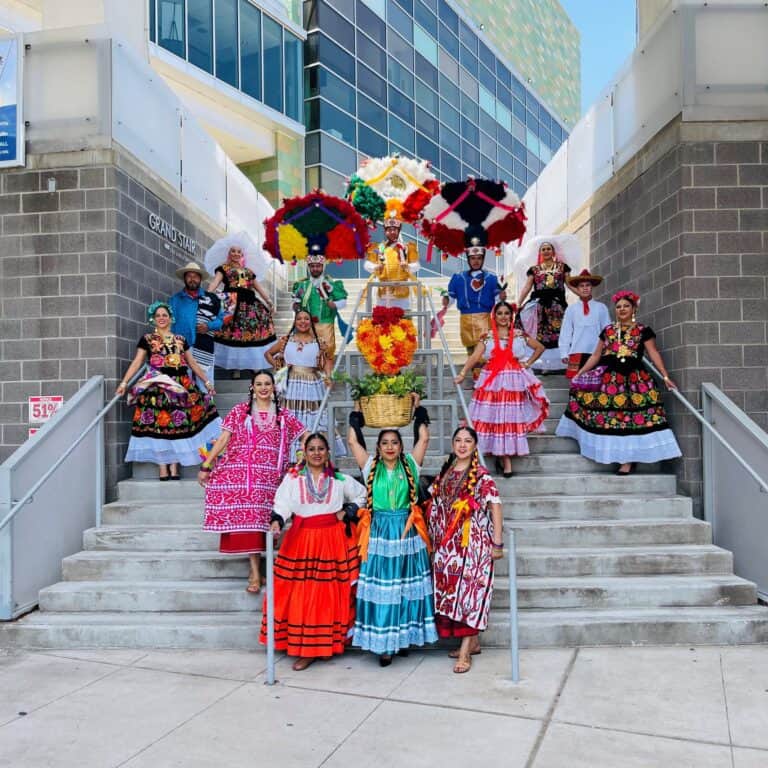
More from the community
Explore stories & interviews from other organizations that have been able to access space because of our rental subsidy program below, or discover a new organization you might have missed at the Long Center this year:
- Health Alliance for Austin Musicians
- Mexican American Cultural Center (MACC)
- Mariachi Rock Revolution
- Roy Lozano’s Ballet Folklórico de Texas, pictured at the top of this blog performing at our 2nd Annual Community Day (photo by Brynn Osborn)
Help us make more community space
So next time you’re looking at our calendar, dig a little deeper to see what other local organizations might be presenting at the LC for the first time. See what they’re up to, give them a follow, and check out their work.
This is what we mean when we say “let’s fuel community through creativity,” which involves you, too! When you support the Long Center with a donation this season, you’re supporting the Soul of Austin and everything that makes that soul special. That means in 2025 we’ll be able to provide even more subsidies, open our doors to many more groups, and keep working towards true community spaces.
It’s a big week in Austin music history. If you haven’t heard by now, it’s the 50th anniversary of the pilot episode of Austin City Limits featuring Willie Nelson, who performed on the now iconic television show for the first time in 1974. Exactly 50 years later (exactly!), on October 17, Willie Nelson & Family take the stage again, but this time at the Long Center.
In this Mid-Week Intermission, hear from long-time ACL TV Executive Producer, Terry Lickona, on his unique perspective of the longest-running music television series ever and what it means for Austin, while we await Thursday’s 50th Birthday Bash.
Meet Terry Lickona, Executive Producer of Austin PBS' iconic television series, Austin City Limits.
Long Center: Welcome to Mid-Week Intermission!
We usually ask people for a song to go with their interview — does anything come to mind? A Willie song, perhaps?
Terry Lickona: “Funny How Time Slips Away”

LC: We understand that you’re a New Yorker, but you obviously got to Texas as quick as you could. What’s your background and how did you get tangled up in the Austin music scene?
(For those not familiar with Terry’s time in the music television business, they should check out this quick Austin PBS writeup, honoring his 2024 Beacon Award.)
Terry Lickona: I’m from Poughkeepsie NY, and after getting my college degree in American History, I worked as a radio DJ. I moved to Austin in 1974 when I was in my 20s and my first job was at KUT Radio, which happened to share the same building as KLRU. I’m not a musician, but have always loved music. I moved to Austin with a musician friend to check out the scene here, and stayed!
LC: We know that Willie joined ACL TV for the first-ever episode way back in 1974, a few years before you got to the show. Can you walk us through how significant it is that he’s returning for year 50? What was that conversation like?
Terry Lickona: When we realized a few years ago that our 50th anniversary was approaching, we thought, “Wouldn’t it be cool to get Willie to do a new show on the same exact day that he did our original pilot show back in 1974?” He’s appeared on ACL more times than any other artist, so it was a no-brainer. We reached out to his management about 6 months ago to start the ball rolling.
LC: And how significant is this milestone for the show? When you joined the crew, did anyone think that the show would be running all these years later?
Terry Lickona: There is no other music program on television anywhere in the world that has been in production continuously for 50 years, and very few programs of any kind. So it is a significant milestone for ACL, of course, but also for broadcast television and PBS in general.
LC: Any favorite episodes come to mind that especially speak to the spirit of the show?
Terry Lickona: Too many to list! But a few standouts: Stevie Ray Vaughan, Ray Charles, Leonard Cohen, Dolly Parton, Kendrick Lamar, Jon Batiste, Brandi Carlile.
LC: What’s the secret ingredient that allows ACL TV to continue to capture the zeitgeist in a city that’s changing as fast as Austin is now?
Terry Lickona: No secret. We create a relaxed, friendly environment for an artist or band to do what they do best — make music — with an enthusiastic, live audience of Austin music fans. Then we capture it all in the highest quality video and sound, and that magic is preserved for posterity and shared with millions of viewers.
LC: We’re incredibly honored to get to host the 50th Birthday Bash out on our 3d-printed stage in front of Austin’s iconic skyline (a nice homage to the show’s in-studio backdrop). How special is that?
Terry Lickona: All of our shows are recorded in our home venue at The Moody Theater, so it’s extremely rare to step outside our “safe space” to stage and capture a show outside and for the general public to share. One of the special highlights is that for the first time ever, we will have the actual, live City of Austin skyline as our backdrop, instead of the replica we have at The Moody Theater.
LC: Having produced the show for so long (and some Grammys along the way), what keeps you here, making Austin City Limits happen for the world? Anything you’ve learned in your 50 years of producing that really sticks with you?
Terry Lickona: Besides being fun, it’s important to capture so many one-of-a-kind music performances to share with the world. It’s become an archive of not only American music, but music from all over the world. One important thing: keep the good music coming, and keep it simple.
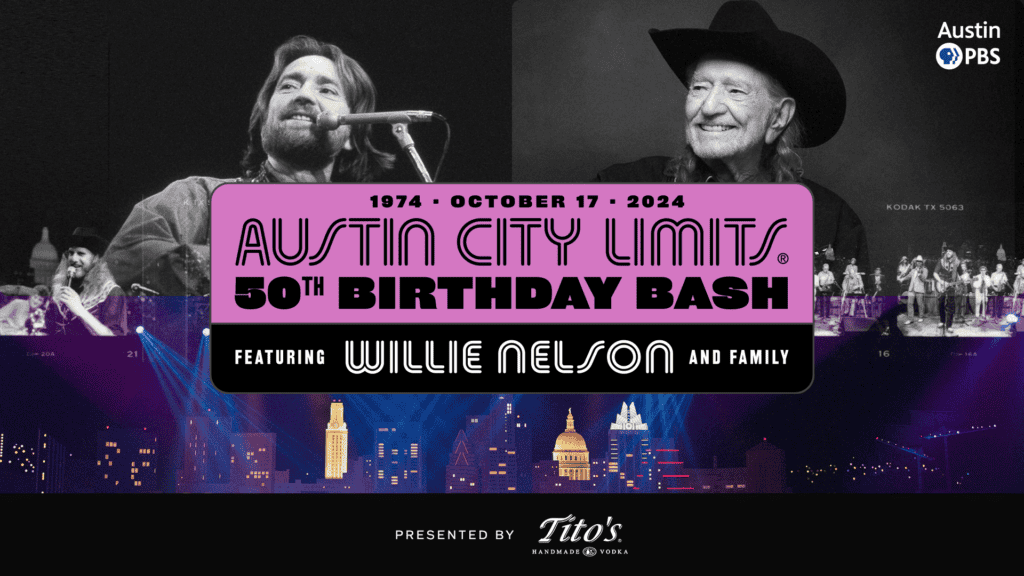
Thanks, Terry!
Be sure to tune into the Austin City Limits 50th Birthday Bash livestream, happening October 17 at 7pm Central and streamed straight from the Long Center lawn.
Find it on ACL TV’s event website or on their YouTube channel. Don’t be late!
A huge Japanese festival is about to take over the Long Center on Sunday and we couldn’t be more excited. Seriously, just take a look at this schedule of events! For months we’ve been looking forward to the #OitaATX Japan Summer Festival, presented by the Austin Oita Sister City Committee, and with so much to take in on the day we knew we had to dig in. We sat down with Kristie Bryant, Chairperson of AOSCC and Austin Sister Cities International to learn more about Oita, Japan, Austin’s sister city relationships, and more about the festival.
Kristie Bryant + Austin Oita Sister City Committee
Long Center: Welcome to Mid-Week Intermission!
We usually ask people for a song to go with their interview — does anything come to mind?
Kristie Bryant with AOSCC:
匹田大智(Taichi Hikida)-Marcelo Miyamoto
(A modern-rock shamisen Japanese guitarist from Oita who will be performing at the Festival. Kristie talks more about the artist later on.)
LC: You are a part of the Austin Oita Sister City Committee, and we’re betting a lot of people don’t know what that is. Can you explain what a Sister City is and how Austin and Oita became paired?
KB: President Dwight D. Eisenhower created the Sister Cities program in 1956 after WWII to foster bonds between people from different communities around the world. He thought that if people from different countries could appreciate their differences, they would be less likely to go to war with each other. A relationship is officially recognized after the highest elected officials of each entity sign off on an agreement to become Sister Cities.
Austin and Oita, Japan, became Sister Cities in 1990. At that time, there were business interests developing between Oita and Austin, and several people had a strong relationship with Oita University and the University of Texas at Austin. There were also semiconductor factories starting up in both cities and a marathon running culture. Through those connections, a Sister City interest formed.
The Austin-Oita Sister City Committee is a non-profit board that oversees the relationship with Oita, Japan. We are all volunteers in Austin. The City of Oita oversees the Japanese side of the relationship.
LC: And what’s your background and role with the Sister City Committee?
KB: I first became involved with the Austin-Oita Sister City Committee when I was a student at UT in the 1990s. I was majoring in international business and also studying Japanese. When my family moved back to Austin from Houston, I became active with the committee again. I am the Chairperson of both AOSCC and Austin Sister Cities International. Austin has 13 sister cities around the world.
- Adelaide, Australia
- Angers, France
- Gwangmyeong, Korea
- Koblenz, Germany
- London Borough of Hackney, UK
- Lima, Peru
- Maseru, Lesotho
- Oita, Japan
- Pune, India
- Saltillo, Mexico
- Taichung, Taiwan
- Xishuangbanna, China
LC: Our building has been BUZZING about the #OitaATX Japan Summer Festival coming up on September 22. Can you tell us how it took shape and a little about what festival activities will take place?
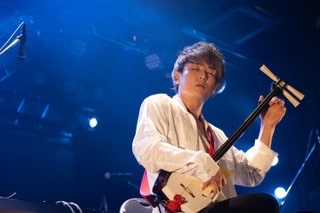
KB: This year will be the ninth time that we have held the festival and we started planning the 2024 festival early this year. Summer festivals are a tradition in Japan. We decided to hold our festival in September after school started and the weather is a bit cooler. Students from APU, Asia Pacific University, are in Austin at UT from September so they are able to take part in the festival. It takes a lot of effort from committee volunteers as we propose and research entertainers and activities.
We were fortunate this year to receive a generous grant from the City of Austin Economic Development, which allowed us to move to a larger venue — the Long Center. We will have entertainment on two stages, including two featured entertainers from Oita: a modern-rock shamisen Japanese guitarist and a performer showcasing Japanese shodo calligraphy. We also will have JPOP, sumo, a tea ceremony, a kimono fashion show, Japanese martial arts, doing business in Japan seminar, a talk on Japanese gardening, and an artisan and festival market place. There will also be numerous hands-on activities for kids and Japanese food and drink.
LC: A quick aside: one thing our staff is anxious to find out about — if this festival is happening here… do Austin festivals happen in Oita??
KB: Pre-COVID, Oita held an “Austin Festival” for school kids and on November 17, Oita will host an American Festival and have an Austin booth there.
Several Austin musicians have had the opportunity to perform at the Oita Yumeiro Music Festival in Japan, largely facilitated by Austin’s Sister City relationship with Oita.
- Gina Chavez has performed at the festival multiple times.
- Project ATX6, a group that sends Austin musicians to international festivals, also brought several artists to Oita. In 2017, participants included Mobley, Otis Wilkins, Little Mazarn, Lindsey Verrill, Acey Monaro, Corey Baum, and Sisi Berry of Torino Black.
- In 2018, I went with Ethan Azarian, Lindsey Verrill, and Jeff Johnston to the festival.
LC: Looking at the festival lineup, there’s so much to experience — from calligraphy to Japanese drumming, martial arts, and even gardening like you described — what do you think is the cultural impact of celebrating our Sister Cities in this way?
KB: First, it encourages the average Austin citizen to “travel” the world without leaving Austin. It allows people to experience the rich traditions and arts of Japan right here in Austin. By bringing these elements together, it helps bridge the gap between different cultures, fostering a deeper understanding and connection. It also highlights the global ties Austin has through its Sister Cities, creating a sense of community and shared experience across borders. This kind of cultural exchange strengthens relationships and brings diversity to the forefront in a meaningful way.
LC: What do you hope that folks take away from the Festival?
KB: I hope that people leave the festival with a sense of connection to another culture and a deeper appreciation for the rich traditions that our Sister City relationships bring to Austin. Whether it’s experiencing Japanese art forms like calligraphy, the rhythm of traditional drumming, or the beauty of a Japanese garden, I want attendees to feel inspired and enriched. It’s about opening up to new experiences, fostering cross-cultural friendships, and realizing how these global relationships make our own community more diverse and vibrant. Ideally, people will leave feeling like they’ve traveled without leaving home, gaining insight and joy from these cultural exchanges.
LC: Once the Festival is over, how can folks experience Oita all year round or follow along with what the city is up to?
KB: Even after the Festival, there are several ways to experience Oita throughout the year. The Austin-Oita Sister City Committee (AOSCC) hosts various events that celebrate Japanese culture, includng an upcoming art exhibit at the Dougherty Arts Center. You can stay connected by following AOSCC’s website, newsletter, and social media, or attending our events like the OitaATX Festival, which happens annually and brings Oita’s cultural highlights to Austin.
In addition to events throughout the year, a great way to stay connected with Oita and other international communities is by attending the Austin Sister Cities International Passport to the World Festival on November 16 at the downtown library. This festival showcases the rich cultural diversity of Austin’s 13 Sister Cities, including Oita, and offers a chance to experience global cultures through performances and interactive activities. It’s a perfect opportunity to immerse yourself in the ongoing cultural exchange and learn more about Austin’s international relationships.
LC: Any teasers about the fest that you can leave us with while we wait for September 22?

KB: I’m really excited about what’s in store for the festival, especially the performance by the shamisen rocker! It’s going to be a unique blend of a traditional Japanese instrument with a modern twist that I can’t wait to experience. For those interested in kimono, “Nanairo Kimono Dressing” is teaming up with talented kimono dressers, including a master from Kyoto, for an unforgettable kimono show. They are presenting the Junihitoe, a stunning formal court dress from over 1,000 years ago, to the Austin public for the very first time! Chikage Windler, Adela Uchida, and Trevor Scott will be emcees. Council Member Chito Vela, Judge Aurora Martinez Jones, and the Consul General of Japan Naganuma will preside over the festival. It’s shaping up to be a day full of surprises and immersive cultural experiences, so stay tuned for an unforgettable event on September 22!
Thanks, Kristie!
The #OitaATX Japan Summer Festival takes place inside the Long Center on Sunday, September 22, from 11am – 4pm and is an all-ages event. Tickets are $20-$25. See their festival schedule for a full list of food & market vendors, performances, and activities!
At the LC, it’s one of our favorite pastimes to be on the lookout for projects, events, and art that build community through creative expression. Believe it or not, there’s no shortage of that in this town! But enter Javier Jara’s unique project Our Rhythms, Our Voices. Performing in Dell Hall on September 8 with Austin Unconducted, we just had to dig deeper to see how this singer-songwriter & composer is celebrating Latin American immigrants by turning their stories into song.
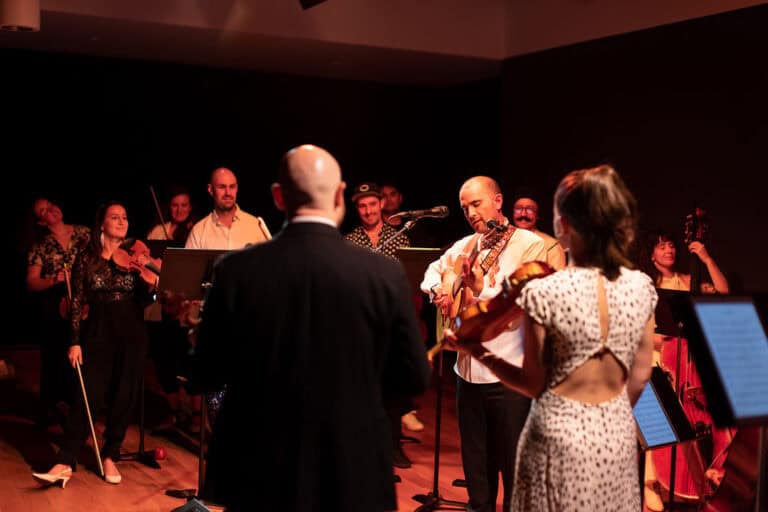
Javier Jara + "Our Rhythms, Our Voices"
Long Center: Welcome to Mid-Week Intermission!
We usually ask people for a song to go with their interview — does anything come to mind?
Javier Jara: Any song or one of my songs? El Necio by Silvio Rodriguez, because it talks about resilience in times of hardship. It touches upon how people keep up with their principals and ideals in spite of overwhelming adversity and general apathy.
If I’m thinking about one of my songs, I would say Alicia, because the song talks about how people sacrifice themselves to help other people. People put their lives on the line for love — love of their family and their community.
LC: First, could you tell us a little about yourself and how you came to be creating and composing in Austin?
Javier: I’ve been singing my whole life, playing the guitar since I was 15, and always playing music that went beyond trivial issues. I studied music at Southwestern University and got my master’s degree from University of Texas in Music and Human Learning. I collaborated with many musicians in Austin with different backgrounds including jazz, folk, Latin American, world, and classical music. I honed my skills in many different styles of Latin American music and produced concerts of music from different Latin American regions including Brazil, Argentina, Peru, Venezuela, the Caribbean, Mexico, and the Andes.
Austin has been a fantastic place to have a career in music. City organizations and nonprofits like the Cultural Arts Division, the ESB-MACC, Texas Humanities, and the Institute for Diversity and Civic Life have all been very supportive and helpful in developing my career. The musicians are amazing in this city as well.
LC: “12 Latin American immigrant stories turned into 12 songs” — this is the premise of your project and upcoming performance with Austin Unconducted. Can you tell us more about the project and who’s involved?
Javier: We noticed the media coverage of Latin American immigrants did not always show the great diversity of cultures and stories existent in Latin Americans living in the United States. I wanted to use my own skills and love of Latin music to show just how incredible the music and stories are from different regions in Latin America.
I became friends with a truly gifted lyricist, poet, and musician from Mexico, Yahir Durán, who listened to all the interviews and wrote the lyrics. Then, I composed the music mostly using a rhythm from the person’s homeland for guitar, voice, violins, percussion, and double bass.
Some of the musicians who played with this ensemble were members of the orchestra, Austin Unconducted. They invited me to be a guest composer and translated three of the songs to be played with the orchestra last spring. That orchestra has some of the finest string players in Austin, Texas, and as the title indicates, they don’t have a conductor. We wanted to present the entire project with the orchestra, so we decided to collaborate again. I co-arranged the songs for orchestra with different members of Austin Unconducted.
Alejandro Moreno-Alanis is a fantastic local photographer, originally from Mexico, who took all the portraits of the people we interviewed.

LC: How does one even embark on a project like this? What was it like to gather these stories and then turn them into a shared musical experience?
Javier: We really wanted to shine a positive light on the Latin American immigrant population in the United States, and we wanted to shift the narrative to people’s individual stories and the various reasons people leave their homelands. We also wanted to interview people with diverse experiences and professions from different regions in Latin America, while making sure to present as many different styles of Latin music as possible.
While we aimed to mostly use rhythms from the person’s homeland, sometimes the people we interviewed requested that their story be set to a different rhythm or style of music, so we changed it. It was a really powerful experience to gather all of the stories, then collaborate with local musicians, and hear the audience’s own stories and experiences after we toured the project.
LC: Now that you’re on the other side of this composing journey, what has it meant for you to go through the process and share these stories in an unexpected way?
Javier: You’re never on the other side of talking about these issues. It’s like you’re on a mountain, and there’s another one to climb. When we traveled with this concert, people have really connected with the music and lyrics. Some people have shared their stories. Others have cried. It has been a very powerful concert in terms of connecting with the audience.
LC: I know a lot of us at the LC are really looking forward to the event on September 8. What would you like people to feel as they walk away from this performance?
Javier: I would like people to have great compassion and empathy for people regardless of their country of origin. I would like people to appreciate the various cultures and experiences of people from Latin America.
LC: Any other projects you’d like to shoutout to our readers? How can they follow your work after Our Rhythms, Our Voices is over?
Javier: I recently was accepted into the Touring Roster program with the Texas Commission on the Arts. I hope to take the Our Rhythms, Our Voices project to other cities in Texas. It would have to be at a smaller scale (like a string quartet rather than a full orchestra) than what we are doing at the Long Center, but I think these people that we interviewed are very impressive, and we would really like to share their storeis with as many people as possible. We have both a website and an Instagram where we will post any updates.
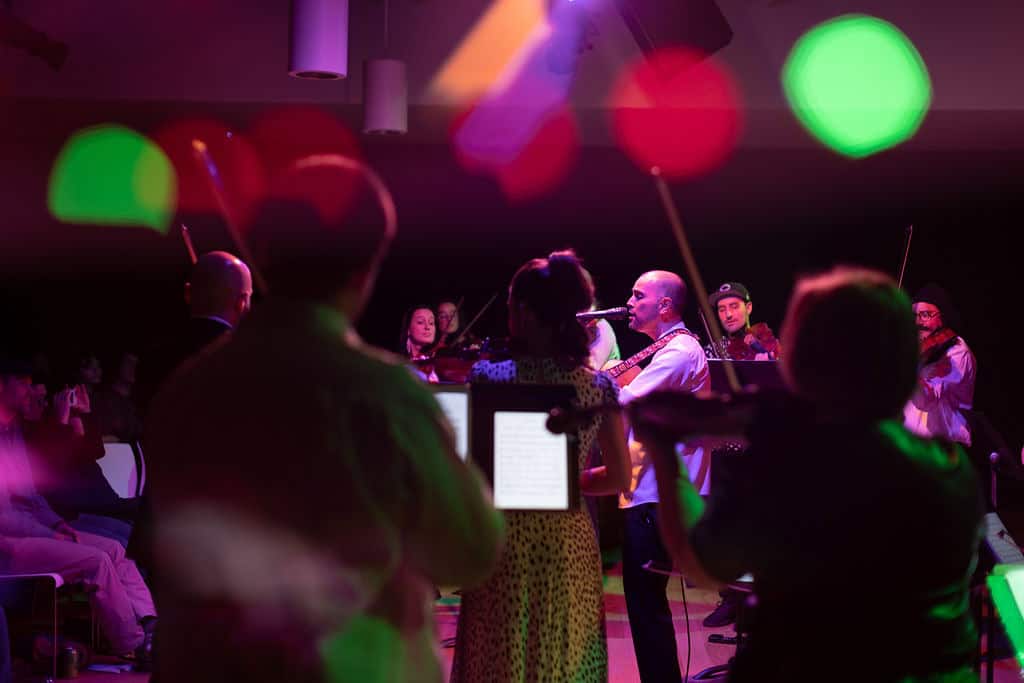
Thanks, Javier!
The Long Center is super honored to have Javier, Austin Unconducted, and the Our Rhythms, Our Voices project in the house on September 8. Enjoy this teaser and we’ll see you there!
If you’ve been in Austin for a minute — or you’ve gone to The Drop-In or Blues on the Green this summer — you’re probably familiar with husband and wife duo Riders Against the Storm. (And if you’re not familiar with Chaka and Qi Dada, check them out ASAP.) What you may not know is the depth and breadth of Chaka’s creative and advocacy activity, so in this Mid-Week Intermission we’re digging deeper to learn about his non-profit DAWA, their upcoming five-year anniversary, and what “giving to the givers” really means.

Meet Chaka and learn more about DAWA, Diversity Awareness & Wellness in Action
Long Center: Welcome to Mid-Week Intermission!
We usually ask people for a song to go with their interview — does anything come to mind?
Chaka: Everyday People — Arrested Development
LC: Some readers will know you from Riders Against the Storm, but can you tell us a little more about your background and what led you to create, advocate, and make music in Austin?
Chaka: I don’t disconnect music from advocacy. It’s my voice, and I use it to speak about things that are important to me, and those I care about. My journey in Austin music brought me into a lot of spaces that were completely ignorant to the lived experiences of BIPOC people in Austin. Yet, and still, they somehow talked as representative of ‘Austin music’ as a whole. This really disgusted me frequently. So, whenever I was in those spaces, I used my voice to inform about perspectives that were missing from their visions and decisions. A lot of times whatever I would say triggered people into fearing my presence, but there were always people in the room that listened, and I formed alliances with those people to create more opportunity.
LC: In addition to your creative work, what led you to form DAWA? Was it something you’d pondered for a long time or a specific event?
Chaka: I formed DAWA because there was a glaring need that most Austin music non-profits, and non-profits in general, were not addressing when it came to the struggles faced by BIPOC people. I tried going to a lot of these organizations with ideas (even joined a Board), but they weren’t ready to act in a responsive way to critical needs.
DAWA was created because I was frustrated, but not powerless to act. I just organized the resources that I had and started, with no intention of actually becoming a non-profit. The non-profit came about due to the communtiy response and feedback I received over time. It became something that I felt Austin really wanted, and I sought out a pathway to make it sustainable. We are still on that path today. Our 5 Year Anniversary is a celebration of our resilience and commitment to growing something vital for Austin’s BIPOC ‘community frontliners.’ We want DAWA to be a cultural institution that lasts well beyond my involvement or oversight.
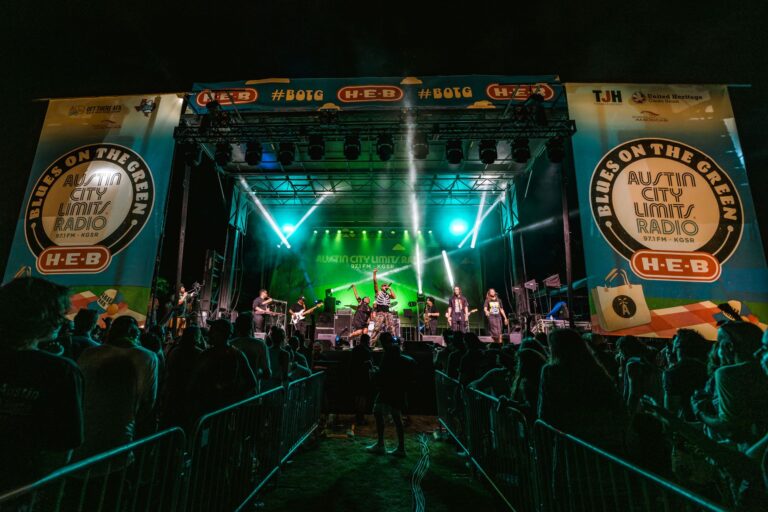
LC: So that our readers know, DAWA’s full name is Diversity Awareness & Wellness in Action. Can you tell us more about DAWA’s mission and “giving to the givers?”
Chaka: Our theory of change is that when you give to those that play giving roles in our community, there is an amplifying effect that makes our entire community healthier and more vibrant. Those that care for and nurture us should be cared for. The givers need to receive. Unfortunately, their roles are not highly valued, so it’s harder and harder to be a teacher, social worker, creative, or healthcare provider in a city like Austin that is growing rapidly. Our mission is to celebrate, elevate, and empower their essential work through direct financial assistance and culturally relevant health-centered programming.
LC: From your perspective as a creative, how are art & storytelling powerful tools, alongside more typical ones, for investing in community health and well-being?
Chaka: Artists are storytellers. Unfortunately, for the most part, much of our cultural production does not benefit us. It is extracted and, generally, others profit from our brilliant visions and innovation. It doesn’t have to be like that. DAWA believes that investing economically in BIPOC community and culture holistically will build a more inclusive and beneficial space that has long-term impact.
I am an example of that. My gifts as a musician and visual artist birthed an entire organization, a physical space for community, and hundreds of jobs. My community’s investment in me had an amplifying effect that grew ideas like DAWA. It’s time for more investment. We are thankful for opportunities like the City of Austin’s Thrive Grant, which has given us a runway to build larger avenues to sustainability.
LC: You have a big five-year anniversary event for DAWA coming up at the Long Center in September (congrats!) — what does this milestone and opportunity for celebration mean to you and the DAWA community?
Chaka: This is a cultural moment of victory for Austin that we are claiming. As we plant our ‘Giving To The Givers’ flag, we are stating that, ‘we are here, and we aren’t going anywhere.’ It’s time for the essential work of BIPOC community frontliners to be centered as a part of the vision for generations to come. It’s going to be a city-wide celebration that marks DAWA’s next phase.
LC: One more teaser for our readers about your anniversary event — what can folks expect from Laughter is Medicine with Tommy Davidson? Any special guests or other hints you can leave us with?
Chaka: Tommy Davidson is a king of comedy. A legend! It’s going to be so amazing to have him commemorate this momentous occasion. Expect to laugh HARD for an incredible cause with thousands of people! Our goal is to raise $100,000 to be distributed via the DAWA Fund in November. Look for special guest announcements soon!

Thanks, Chaka!
The Long Center is super pumped to have DAWA in the house for their five-year anniversary event on September 6. Check it out below and follow @dawaheals for updates!

